LG B5 is truly a great OLED television that shows you don't need to spend a fortune for very good quality. It offers deep blacks typical of organic panels, excellent color reproduction—especially after calibration—and enjoyable HDR movie watching experiences. All of this makes evening viewings capable of delivering cinematic emotions without reaching for significantly more expensive screens. The fluidity of the picture and the set of features for gamers also deserve recognition. A 120 Hz panel, low input lag, full support for HDMI 2.1, variable refresh rates, and Dolby Vision Gaming mode make the B5 a very versatile screen—for both gaming and watching sports. It is complemented by a user-friendly webOS system with a Magic remote that provides convenient access to content and simplifies operation. However, not everything is perfect. Compared to the B4 model, there is a noticeable slight drop in brightness, especially in very bright rooms. For some users, the lack of DTS audio support may also pose a problem, which could necessitate workarounds when connecting Blu-ray players. Despite this, LG B5 remains one of the most sensible choices for those looking to enter the world of true cinema—without overpaying but also without significant compromises. It’s a screen that doesn't need to prove anything—it simply delights the eye with great picture quality and works as it should.
- Matching (Score)
- Our verdict
- TV appearance
- Where to buy
- Contrast and black detail
- HDR effect quality
- Factory color reproduction
- Color reproduction after calibration
- Smoothness of tonal transitions
- Image scaling and smoothness of tonal transitions
- Blur and motion smoothness
- Console compatibility and gaming features
- Input lag
- Compatibility with PC
- Viewing angles
- TV efficiency during daytime
- Details about the matrix
- TV features
- Apps
- Playing files from USB
- Sound
LG OLED B5 vs Samsung The Frame Pro
Direct compare
Check the best price offer:
LG OLED B5Check the best price offer:
Samsung The Frame ProThe Frame Pro / LS03FW
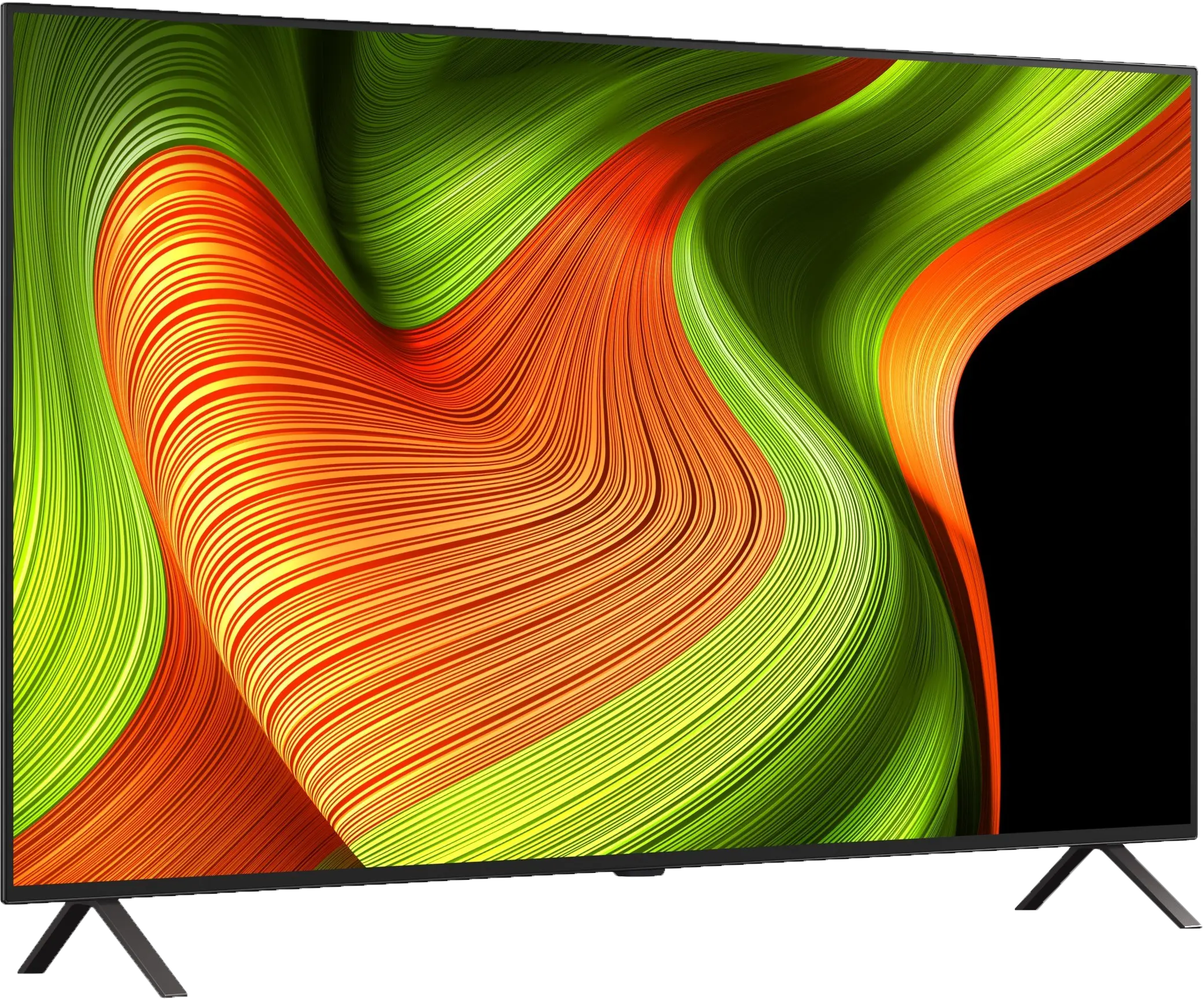

Panel type: WRGB OLED
Resolution: 3840x2160
System: WebOS
Model year: 2025
Complete the survey to find out the result

Panel type: LCD VA
Resolution: 3840x2160
System: Tizen
Model year: 2025
Complete the survey to find out the result

Overall rating
7.8
7.3
Movies and series in UHD quality
7.9
6.8
Classic TV, YouTube
8.6
6.6
Sports broadcasts (TV and apps)
8.5
6.8
Gaming on console
9.2
8.6
TV as a computer monitor
7.6
8.4
Watching in bright light
4.9
7.0
Utility functions
7.9
7.7
Apps
9.1
8.7
Sound quality
7.0
6.4
Complete the survey to find out what fits your preferences
Advantages
Perfect black and contrast
Pleasant picture in HDR format
Outstanding color reproduction capabilities
120Hz OLED panel - excellent motion fluidity
4 HDMI 2.1 ports and full support for gamers (VRR, ALLM, Dolby Vision Gaming, HGiG)
Very low input lag
Correct content scaling and good digital processing
User-friendly webOS system with Magic remote
Built-in USB recording function from built-in DVB-T/T2 tuners
Premium design – symmetrical frame, interchangeable frame customization, true image effect on the wall
Wireless One Connect module – no visible cables by the TV, easier space arrangement
Matte screen coating – no reflections even in bright rooms
High brightness ratio – up to 900 nits
Wide color gamut – QLED
Smooth tonal transitions, practically no banding
High motion fluidity – 144 Hz panel
Gaming features – VRR, ALLM, 144 Hz, Game Bar, low input lag (wired)
Tizen system – fast, intuitive, with a full suite of applications and support for AirPlay and voice assistant
Art Store – unique feature, TV as a digital picture frame
Mount included
Disadvantages
Average brightness and poor performance in bright rooms
No support for DTS formats
Different versions of the remote in derivative models – it's hard to predict which version we will get
It's hard to call it a true Mini-LED – edge lighting
Poor viewing angles (they could be better for improved wall image quality)
No HGiG* feature
Flat sound, little bass. A soundbar will definitely come in handy
Issues with font legibility and significant lag (input lag) when using the wireless One Connect module.
*The HGiG feature disappeared with the latest TV update. We are monitoring the situation, and if anything changes in this regard, we will let you know.
Our verdict
Samsung The Frame Pro 2025 is a television that brings a breath of freshness to the lifestyle model segment. Its design takes center stage – a symmetrical frame, the ability to easily change decorative frames, and above all, the image effect on the wall thanks to the matte coating and special mount. In everyday use, it makes a great impression, and the Art Store feature combined with the high brightness of the screen means that the television works well not only as a display for movies and series but also as a decorative element in interior design. It is also hard not to appreciate the gadget-like addition of the wireless One Connect module – the ability to hide the box with ports anywhere in the living room provides significant design flexibility. In terms of image quality, The Frame Pro holds up quite well. Brightness levels of up to 900 nits in peak scenes allow for enjoyment of HDR effects even in brightly lit rooms, while the VA panel ensures stable and solid contrast. On the other hand, there are quite a few question marks. First and foremost – the naming. The designation "Pro" and the Mini-LED suffix suggest that we are dealing with an advanced local dimming system. However, in the 65-inch variant, we counted only 24 zones, all located at the bottom edge of the screen. You probably already know the effect after reading this review. Black levels and contrast are acceptable, but far from what Mini-LED televisions with full, dense backlighting provide. The issue of the wireless module also raises mixed feelings. While it indeed performs decently for connecting an amplifier or decoder, gamers and PC users will quickly discover that direct connection to the television via MICRO-HDMI is a necessity. Otherwise, they must contend with high input lag and worse font readability. Therefore, it is difficult to truly call The Frame Pro "Pro" in a strictly technological sense – it would be more appropriate to say it's "Frame Plus." A great lifestyle television, polished and visually striking, that will successfully fit into a bright, modern living room, but at the same time, it does not reach the level of quality we could expect from a product labeled as Mini-LED. It is a device that will delight with its design and additional features but will leave a slight sense of disappointment for those who expected a true breakthrough in image quality.
TV appearance
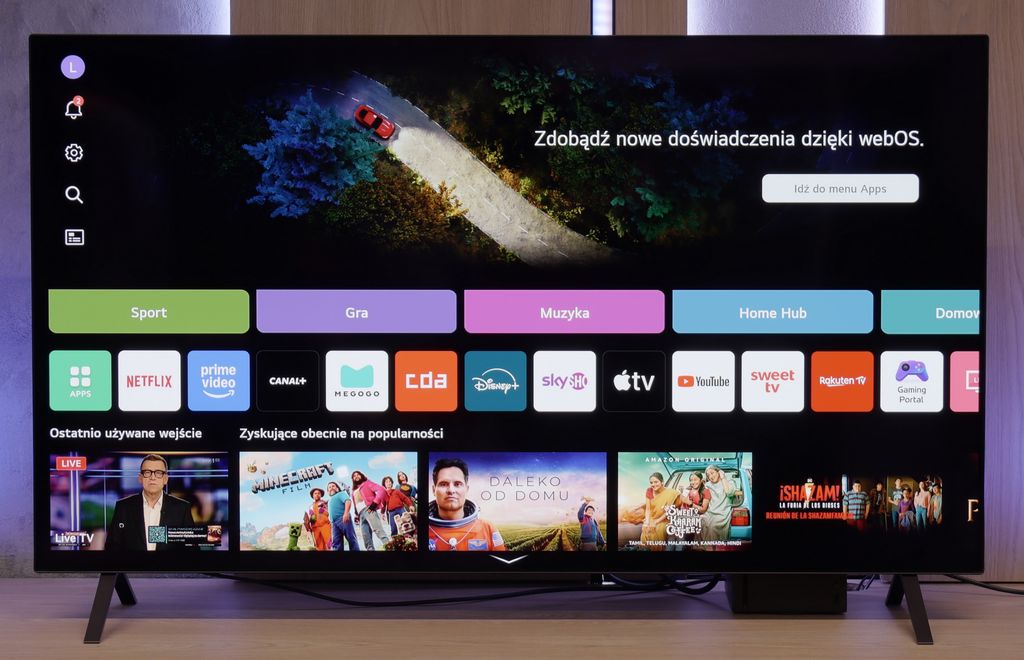
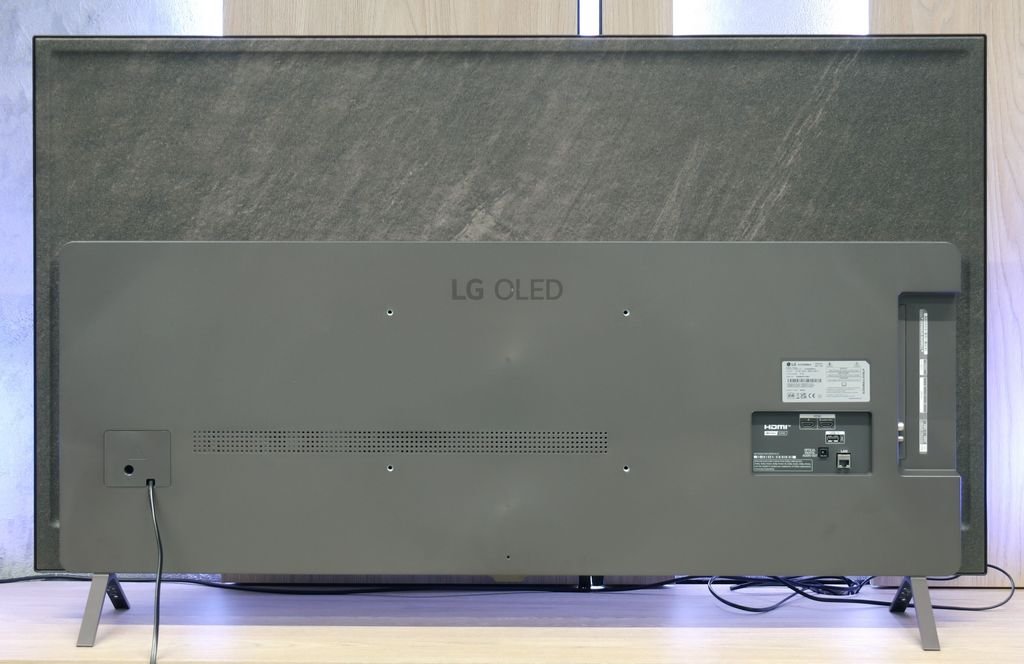
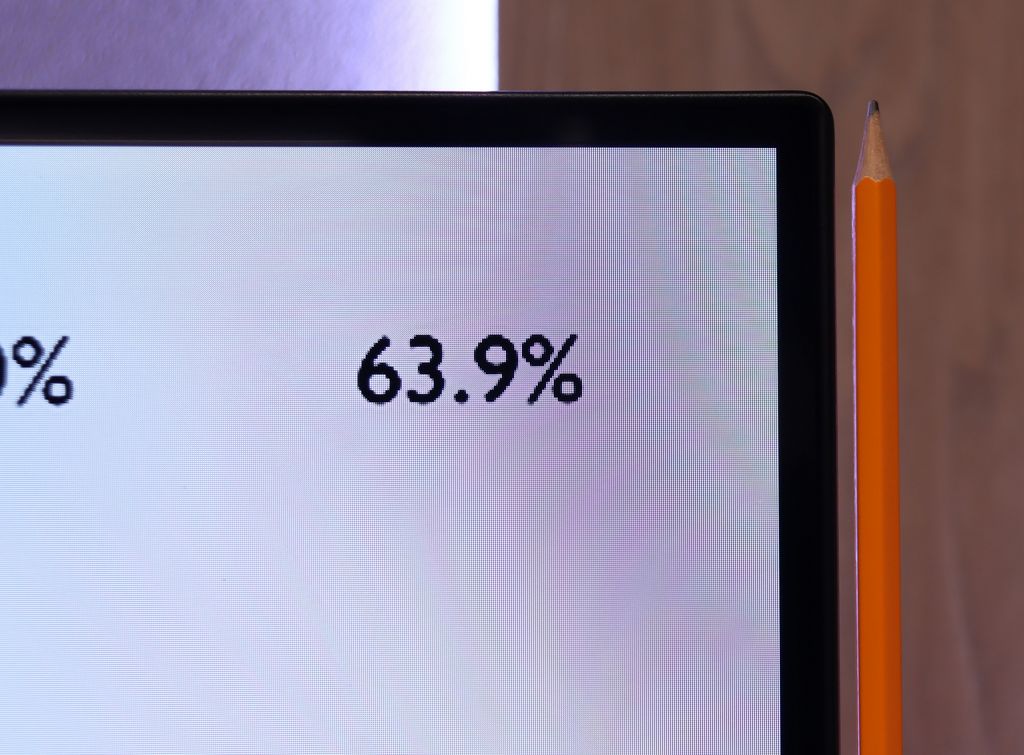
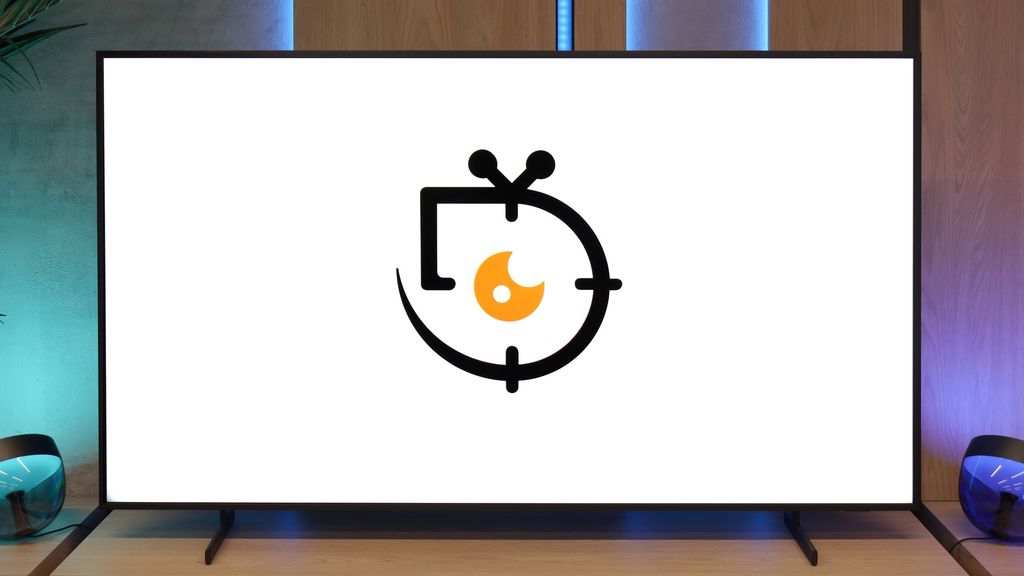
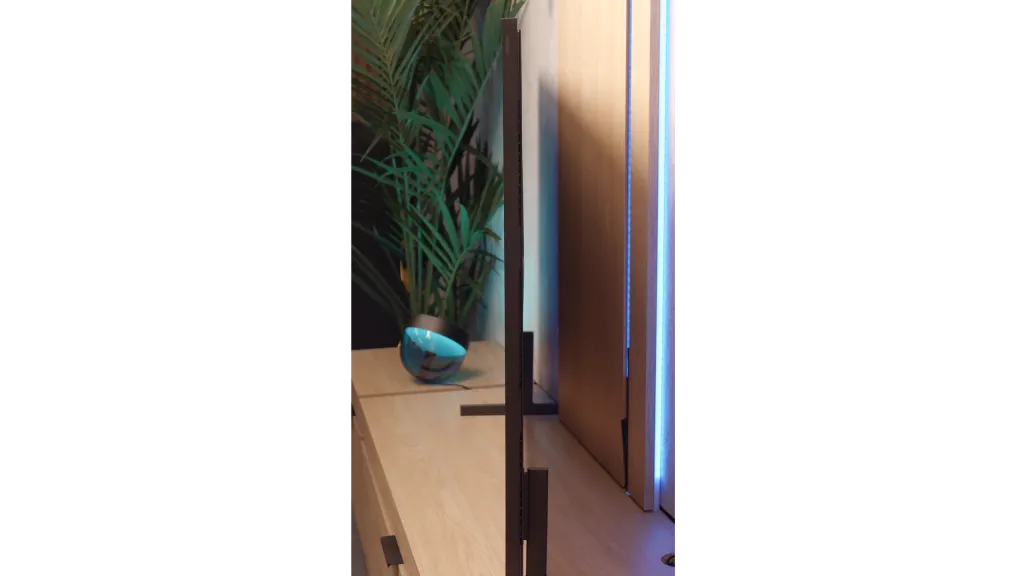
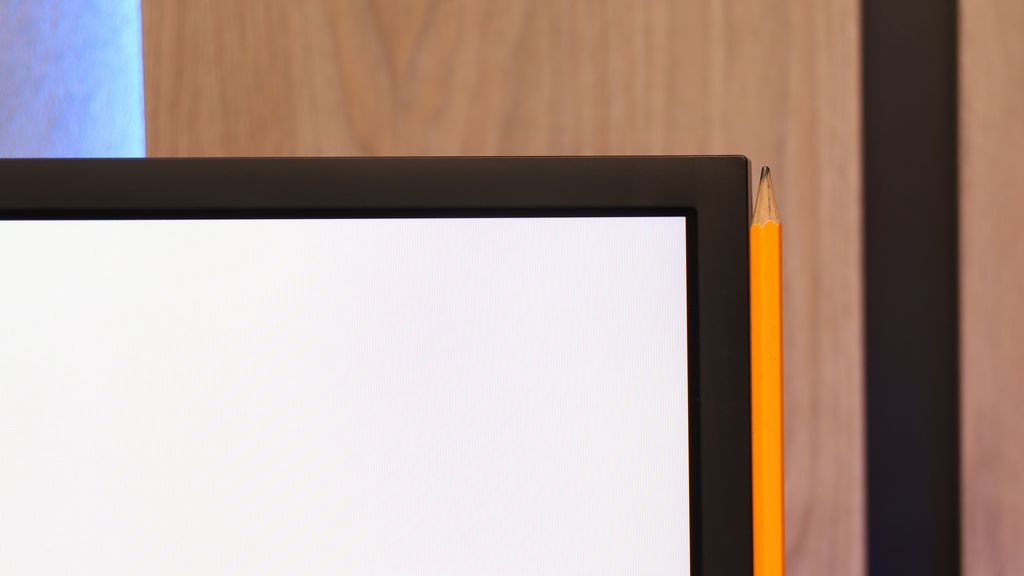
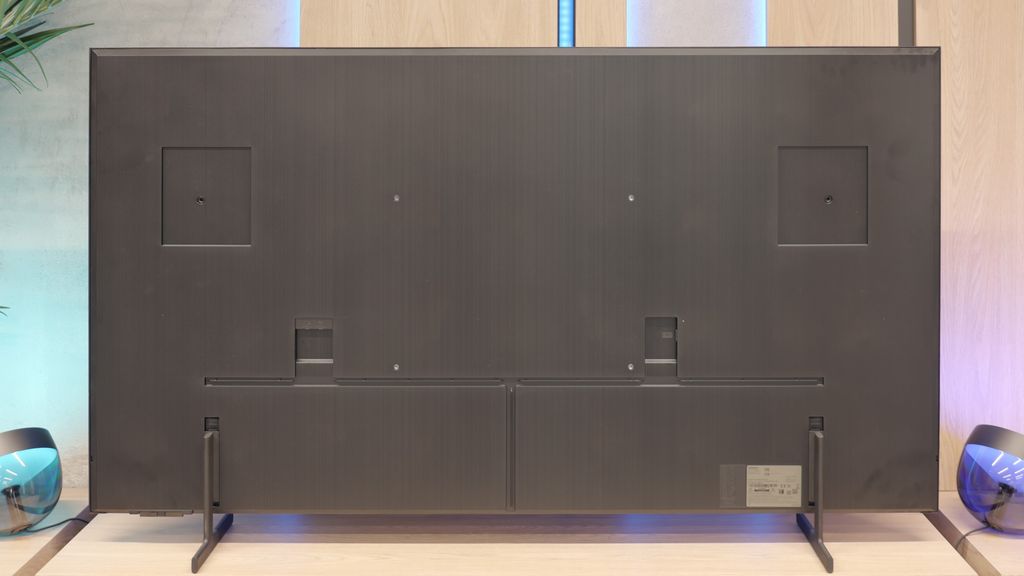
Contrast and black detail
10/10
5.7/10
Local dimming function: Yes, number of zones: 24 (1 x 24)
Contrast:

Result
∞:1

Result
∞:1

Result
∞:1

Result
∞:1

Result
∞:1

Result
6,250:1

Result
5,100:1

Result
4,650:1

Result
4,350:1

Result
4,300:1
Halo effect and black detail visibility:
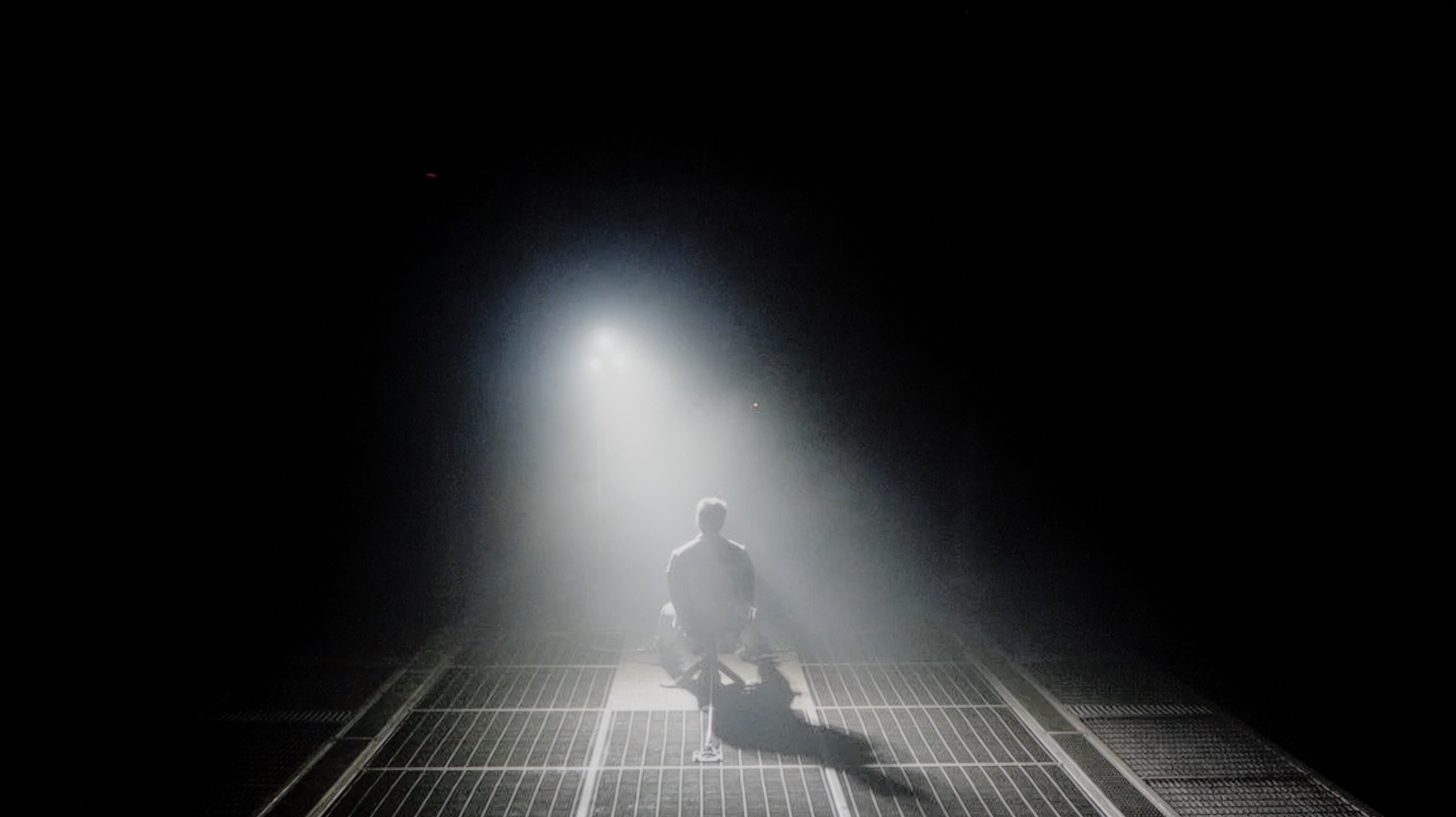
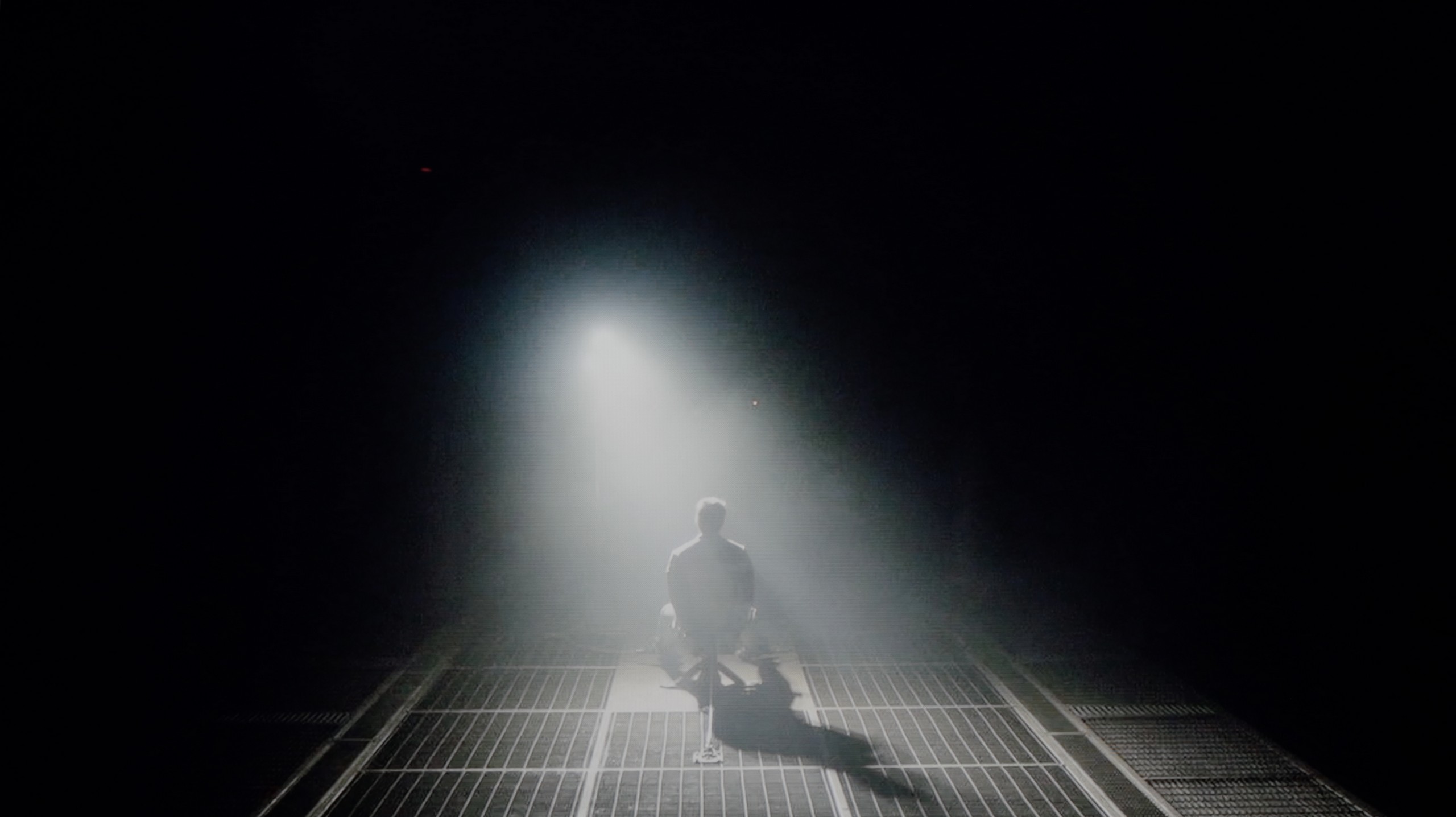
If you're looking for changes compared to last year's LG B4, we'll dispel any doubts right away - you won't find any in this category at all. And that's a good thing. Because how do you improve something that already borders on perfection? The LG B5, as is fitting for an organic WOLED screen, offers pitch-black scenes and contrast that's hard to find even in the most expensive LCD displays. The screen is as clear as a tear – no bleed-through, no smudges, no halo effects that can ruin the atmosphere in cinematic scenes. Everything is in its place here. Details separate from the black with surgical precision, nothing blends together, even in the most demanding sequences from movies like The Revenant or Oblivion. This is the type of TV that can enchant you especially when the room goes completely dark. When the lights go out, the LG B5 takes center stage – and it does so magnificently. In these conditions, OLED shines the brightest, and even top LCD models – despite advanced dimming and hundreds of zones – simply fall behind.
Samsung The Frame Pro has officially been labeled as a Mini-LED backlit television, but… is it really? In the 65-inch variant we tested, we counted only 24 dimming zones. The number itself seems somewhat modest, but the more important aspect is their placement – all of them are located along the bottom edge of the screen. In practice, this means that The Frame Pro should be treated more as edge-lit rather than a full-fledged Mini-LED with dense, direct local dimming. Samsung has used a similar maneuver before, renaming the Q70 series to Neo QLED televisions – mainly for marketing purposes. How does this translate to picture quality? Black levels and contrast look decent, but there are no effects known from televisions with advanced local dimming like in the QN80 series. Much of this is due to the high-quality VA panel, which provides solid parameters on its own – a contrast ratio of about 5000:1 looks good and, importantly, is stable without significant fluctuations. However, if someone buys The Frame Pro hoping to experience “true Mini-LED,” they might feel disappointed. We ourselves expected this model to differentiate itself more from the classic The Frame series in terms of contrast quality; however, the differences turned out to be smaller or even nonexistent compared to what the “Pro” designation might suggest.
HDR effect quality
6.2/10
5.8/10
Luminance measurements in HDR:

Result
587 nit

Result
593 nit

Result
628 nit

Result
589 nit

Result
470 nit

Result
745 nit

Result
458 nit

Result
476 nit

Result
446 nit

Result
660 nit
Scene from the movie “Pan” (about 2800 nits)


Scene from the movie “Billy Lynn” (about 1100 nits)


Static HDR10


Dynamic: Dolby Vision
Dynamic: HDR10+


HDR luminance chart:
Samsung The Frame Pro
HDR luminance
LG OLED B5
HDR luminance
Luminance of RGB colors
LG B5 is a moderately bright OLED TV. Regardless of the scene, it can generate around 500 nits of peak brightness. And interestingly, it does this even in full-screen shots flooded with white, where most OLEDs usually fall short. So, is this screen suitable for HDR movies? Yes – absolutely, because such brightness really allows you to feel the magic of HDR effects. However, it's worth noting that compared to last year's model B4, the new B5 is darker – by about 100 nits. It may seem like a small difference, but at such average peak values, it makes quite a significant difference. Fortunately, the TV makes up for it with another advantage – excellent coverage of the DCI-P3 and BT.2020 color gamut. As a result, HDR movies look really colorful, vibrant, and impressive even in more demanding scenes.
Samsung The Frame Pro belongs to relatively bright televisions. In synthetic tests, we managed to achieve values around 900 nits, which, for a lifestyle model, is quite a decent result. In full-screen scenes, such as the frame from the movie The Meg or the opening sequence in Life of Pi, brightness remained at levels of 700–800 nits. These are values that allow you to fully enjoy HDR effects and capture their cinematic magic. However, the situation complicates when smaller, point light sources appear on the screen. The edge lighting used here, equipped with the ability to locally dim entire strips, does not handle them very well. It sometimes happens that small elements are excessively dimmed, which weakens the effect, or on the contrary – they are significantly brightened, but at the cost of losing black depth in that part of the image. This can be compared to light glows resembling the spread of a laser beam in dense fog – the effect is visible and bright, but at the same time, it is not very natural and distracts our attention. Fortunately, the color aspect performs better. Thanks to the use of a quantum dot filter (QLED), the colors are saturated, and the reproduction of the DCI-P3 palette exceeds 92%. In general, movies or series watched in HDR on The Frame Pro present a rich color palette, even if the contrast and the operation of the backlight algorithms can sometimes distract our attention.
Factory color reproduction
8.2/10
5.5/10


Factory Mode
After calibration
We tested the B5 in Filmmaker mode and... we would like to see more TVs like this straight out of the box. Really. The white balance is set very well – there is practically nothing to complain about. Well, if one were to be very picky, one might notice a slight deficiency in blue, which makes the overall picture have a slightly yellowish tint. But that’s just our editorial nitpicking. Most of you probably won't even notice it. We also have some minor reservations about brightness management in HDR format. The EOTF curve – that is, the one responsible for how the TV distributes brightness in a scene – is slightly below the ideal. In practice, it can happen that the darkest parts of the image may be displayed too dark and simply... disappear. But these are details that only come out in measurements. Overall: we are impressed. But we also know that LG TVs respond very well to professional calibration. They can produce nearly reference-quality images, so – even though it's already very good out of the box – we allowed ourselves to take an extra step and fine-tune everything to perfection.
The best results were, of course, achieved in Filmmaker mode, which immediately showed that Samsung paid attention to the factory settings. In SDR content – the type of content most often viewed – The Frame Pro performed really well. White balance and gamma were almost perfectly matched, making the image look natural and consistent. Yes, there were some noticeable errors, especially in skin tones and reds, which could be overly saturated, giving everything a slightly “warmed up” character, but in everyday use, this did not significantly affect the viewing experience. In the case of HDR content, the situation was similar regarding white balance. It was at a good level; however, the biggest problem turned out to be brightness management. The EOTF curve was set in such a way that in many scenes the image appeared to be overexposed, and the brightest areas lost details and turned into solid patches of light. This severely undermined realism and made the colors appear strongly over-sharpened. Fortunately, Samsung provides the option for manual adjustment of the curve in its televisions, so we opted for calibration, and its results can be seen below.
Color reproduction after calibration
9.1/10
8.5/10
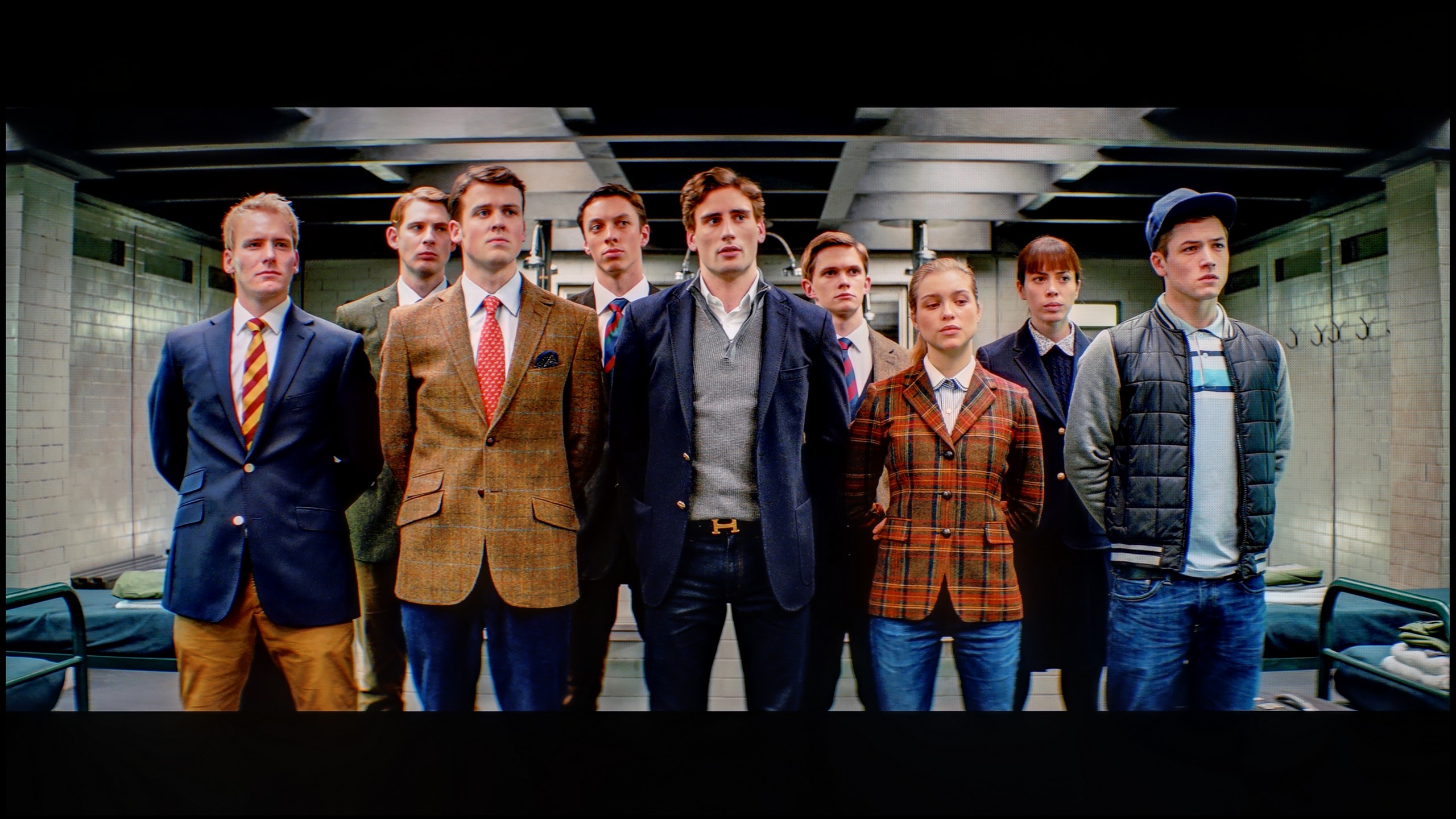
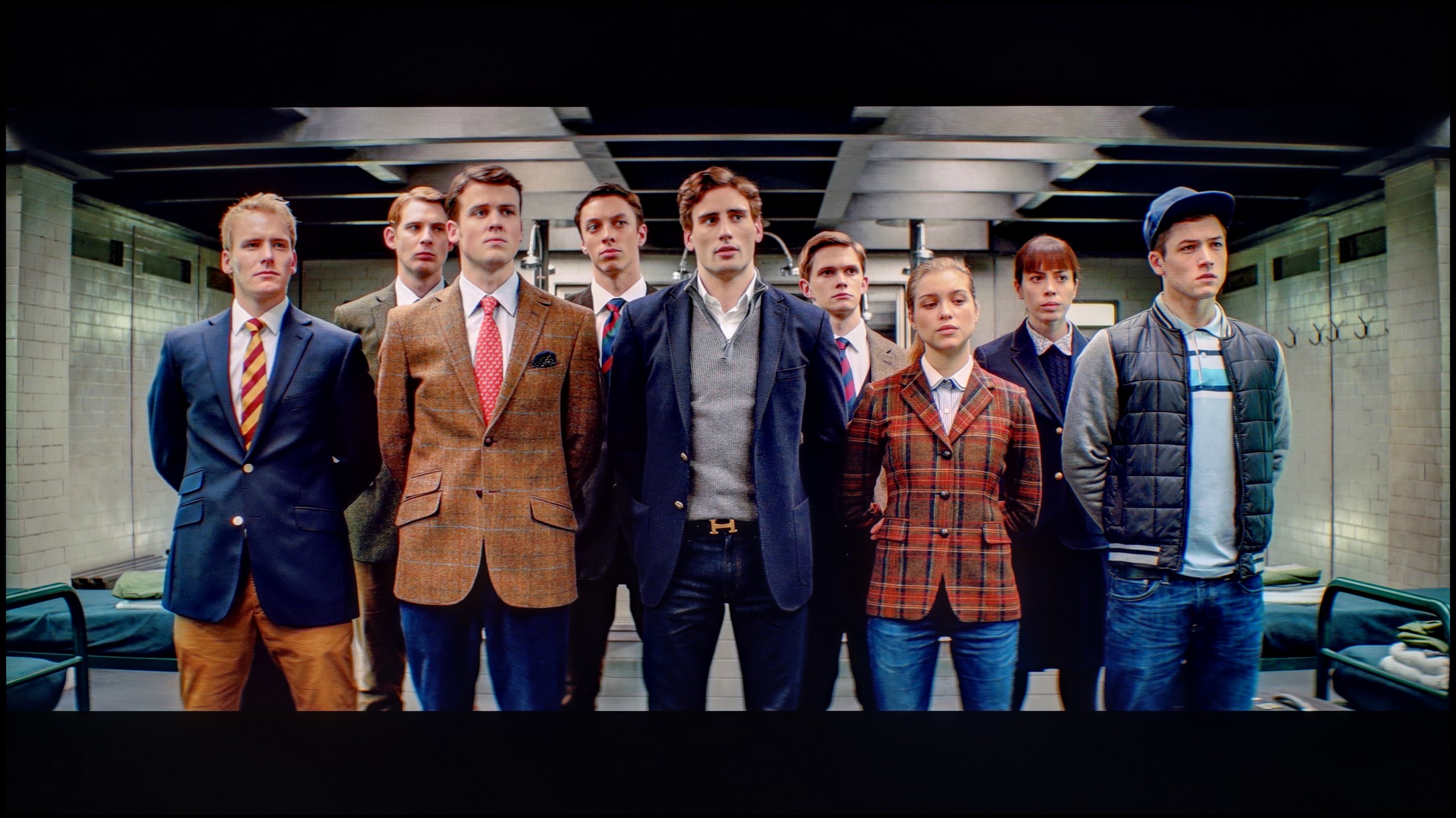
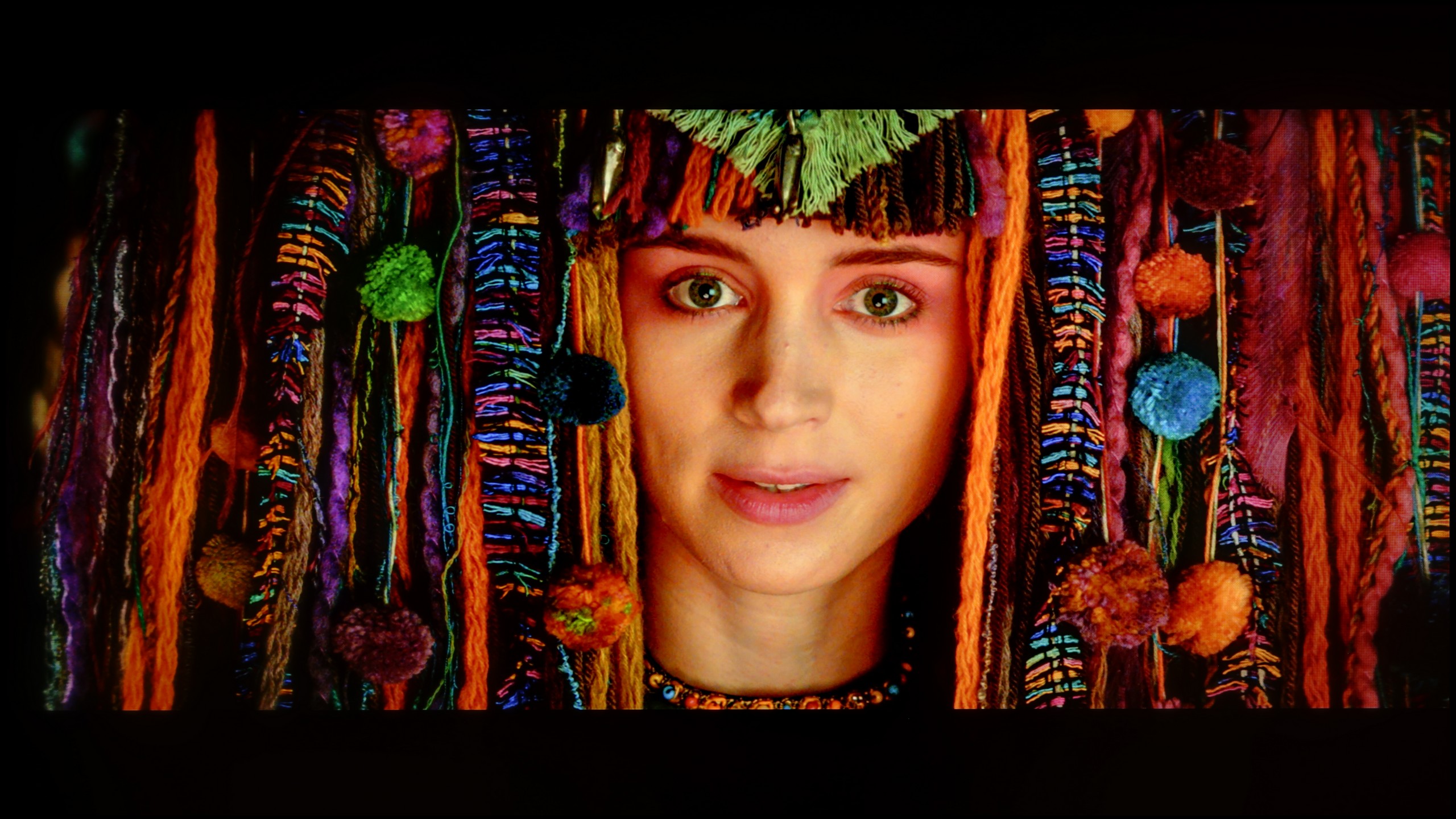
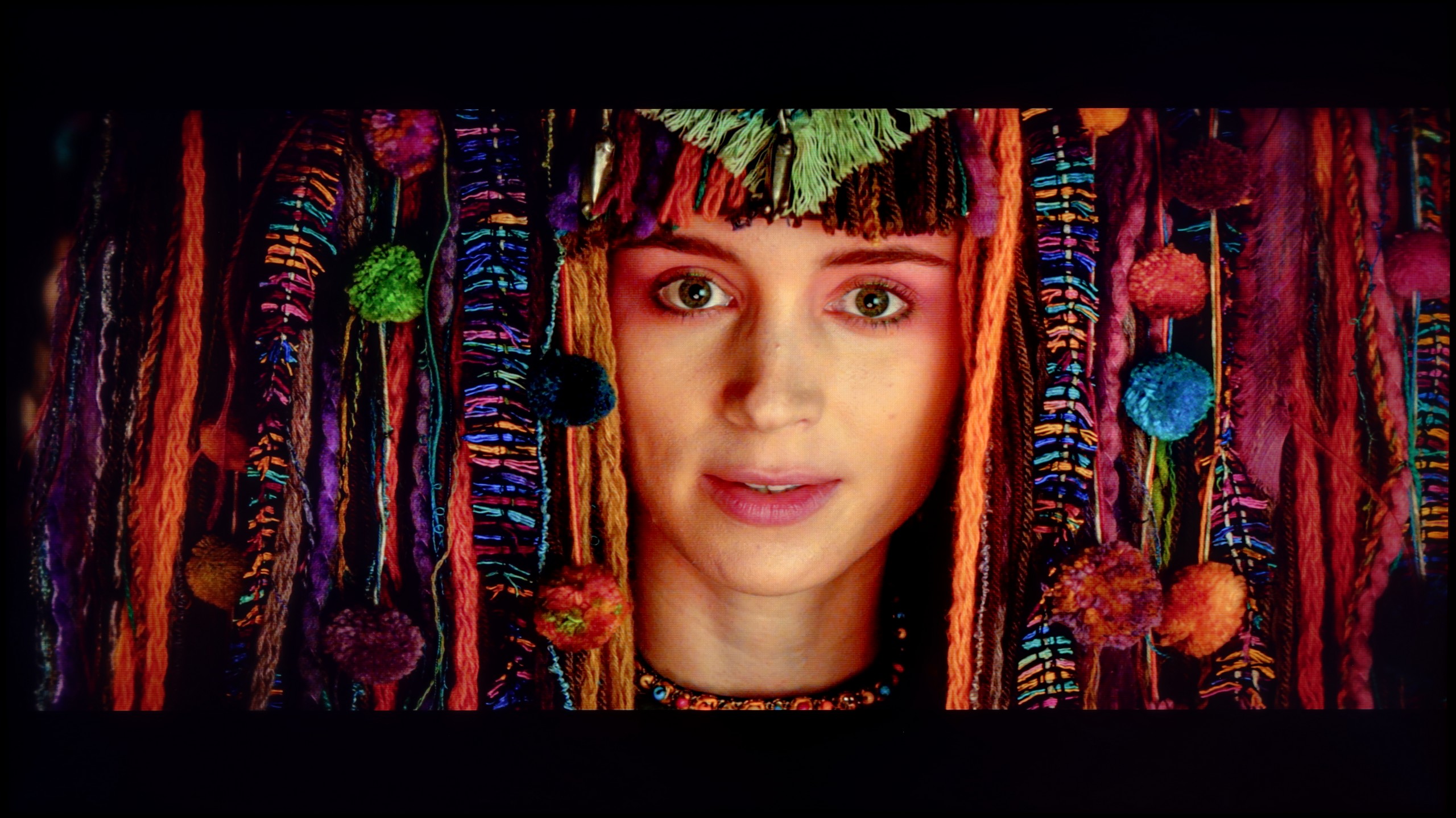
We must admit that we didn't have much work with the LG B5. It's one of those TVs that looks good right from the start, but after calibration… it can really impress. The white balance was brought to almost perfect levels – to a degree of error invisible to the human eye, unless you are a professional colorist with a magnifying glass at the screen. We also managed to control the TV's slight tendency to dim the darkest details, especially in HDR scenes. After proper tuning, everything looks coherent: the black is still deep, but not information-hungry. The highlights retain a natural sparkle, and the colors align with the director's vision. It's really one of those models that show you don't have to spend a fortune to get almost reference-quality image. If you can decide on professional calibration – it's definitely worth it for the B5.
After calibration, the SDR mode looks simply perfect. We managed to eliminate the overly strong red saturation that previously gave the picture a somewhat excessively warm character. The colors became more balanced, which translated to a natural and pleasant reception of daily content – from television to movies and series from streaming or materials on YouTube. In HDR mode, the EOTF curve required the most work, as it originally caused excessive burning of the entire image. Calibration largely helped to "tame" this problem – the image stopped being overexposed, and details in bright areas became more visible. Of course, the limits are set by the television's own design, as edge lighting reveals its limitations, and even the smallest elements of light can still be oversaturated or blend into the background. However, this is a matter of technology, not calibration itself. After the correction, The Frame Pro is much more enjoyable to watch, and it's definitely worth opting for if you want to make the most of your television's capabilities.
Smoothness of tonal transitions
7.2/10
9.5/10




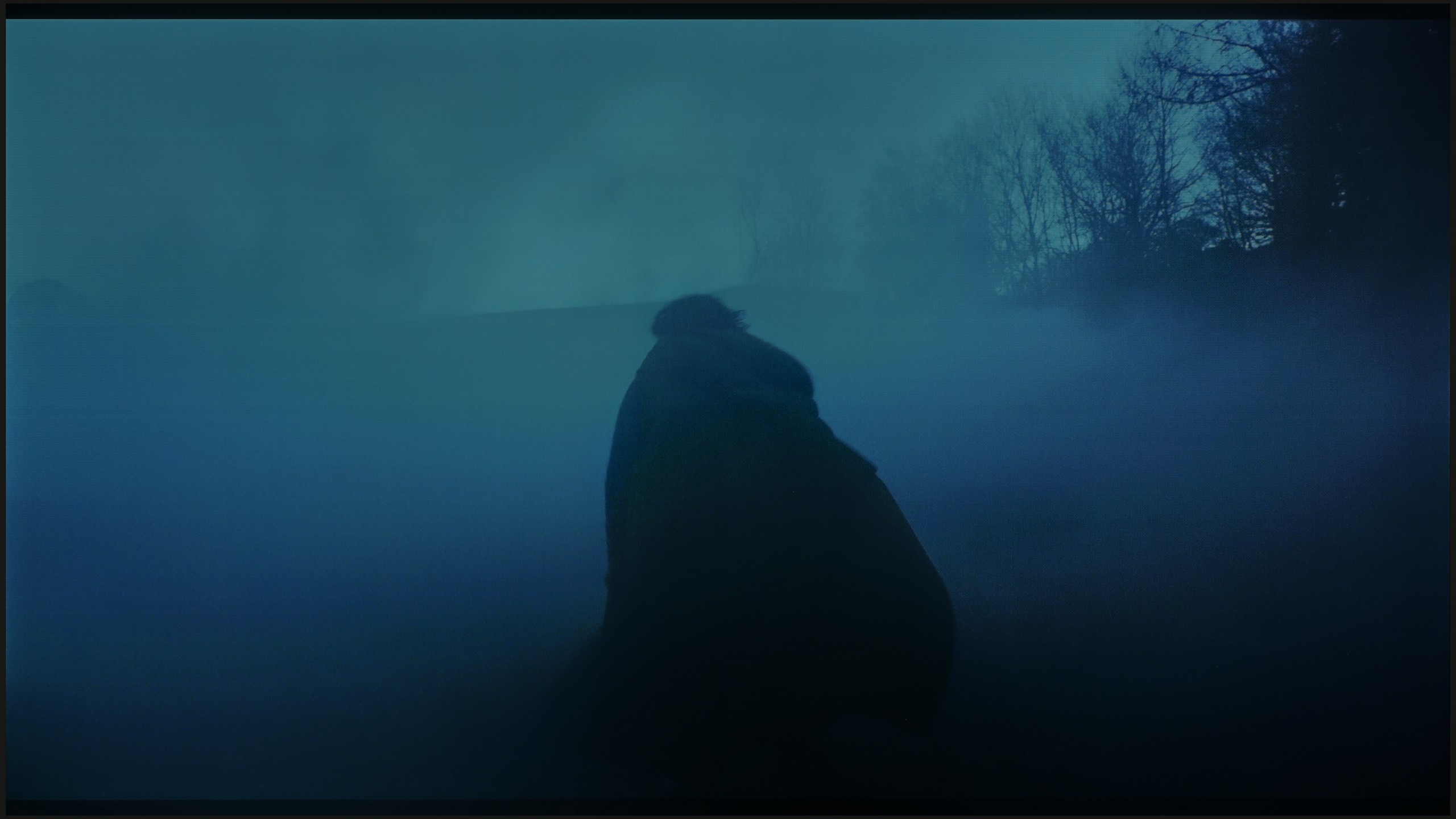
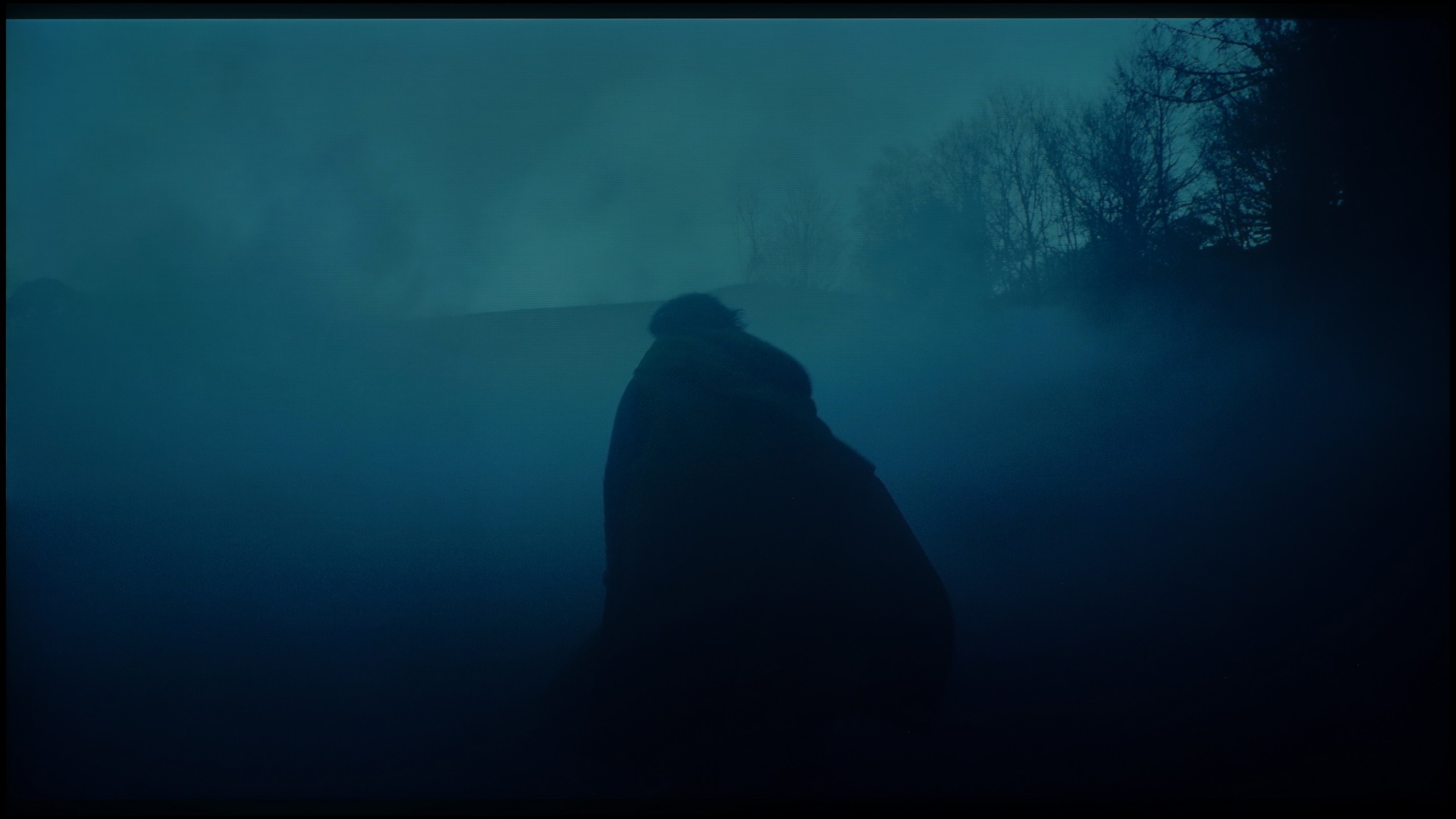
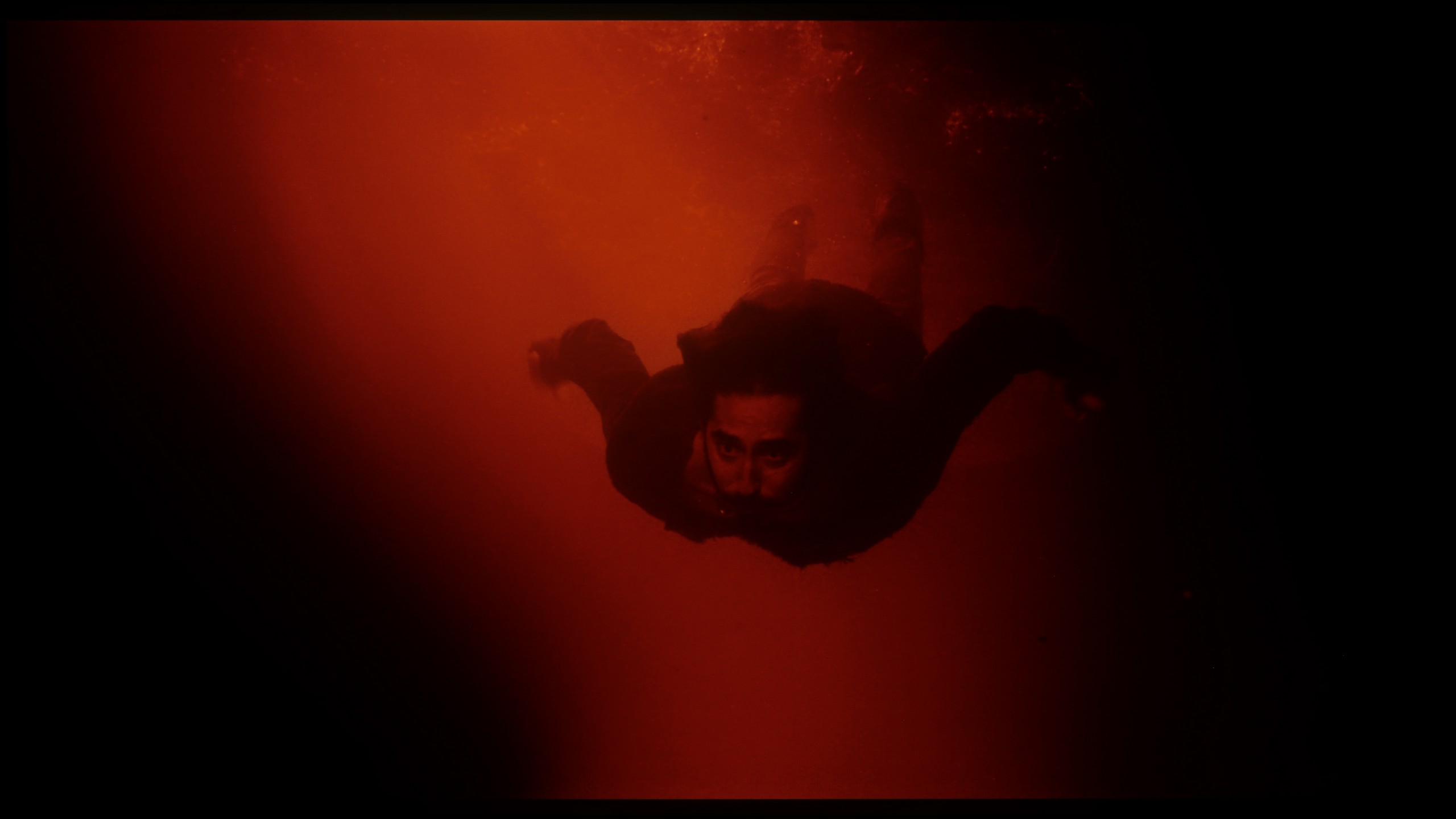





LG B5 handles color gradation quite decently. In bright scenes, where we have smooth transitions between skin tones, the sky, or backgrounds, the television merges colors seamlessly and without issues. At first glance – it's good, especially considering the price. But it's enough to reach for more challenging material – those darker, more demanding scenes with a lot of subtle transitions – and the problems begin. Minor artifacts, false contours, slight bumps appear. It's still not a level that stands out or distracts from the plot, but the difference compared to more expensive WOLED models – and even more so QD-OLED screens – becomes noticeable.
Here Samsung truly deserves immense applause. The Frame Pro has proven to be one of the best TVs of the year when it comes to the smoothness of tonal transitions. During testing, we were practically unable to detect any noticeable issues with color blending – the gradients looked smooth and natural, and the "banding" typical of many TVs simply did not appear. Yes, in very dark scenes, minimal imperfections can be noticed, but you have to really focus to see them – even the seasoned eye of our editorial team had trouble with this. Therefore, in everyday viewing, there’s no way anything will disrupt your experience. This is a huge plus because it’s in darker scenes that TVs most often struggle. You won’t experience that here.
Image scaling and smoothness of tonal transitions
7.5/10
7.5/10
Smooth transition function
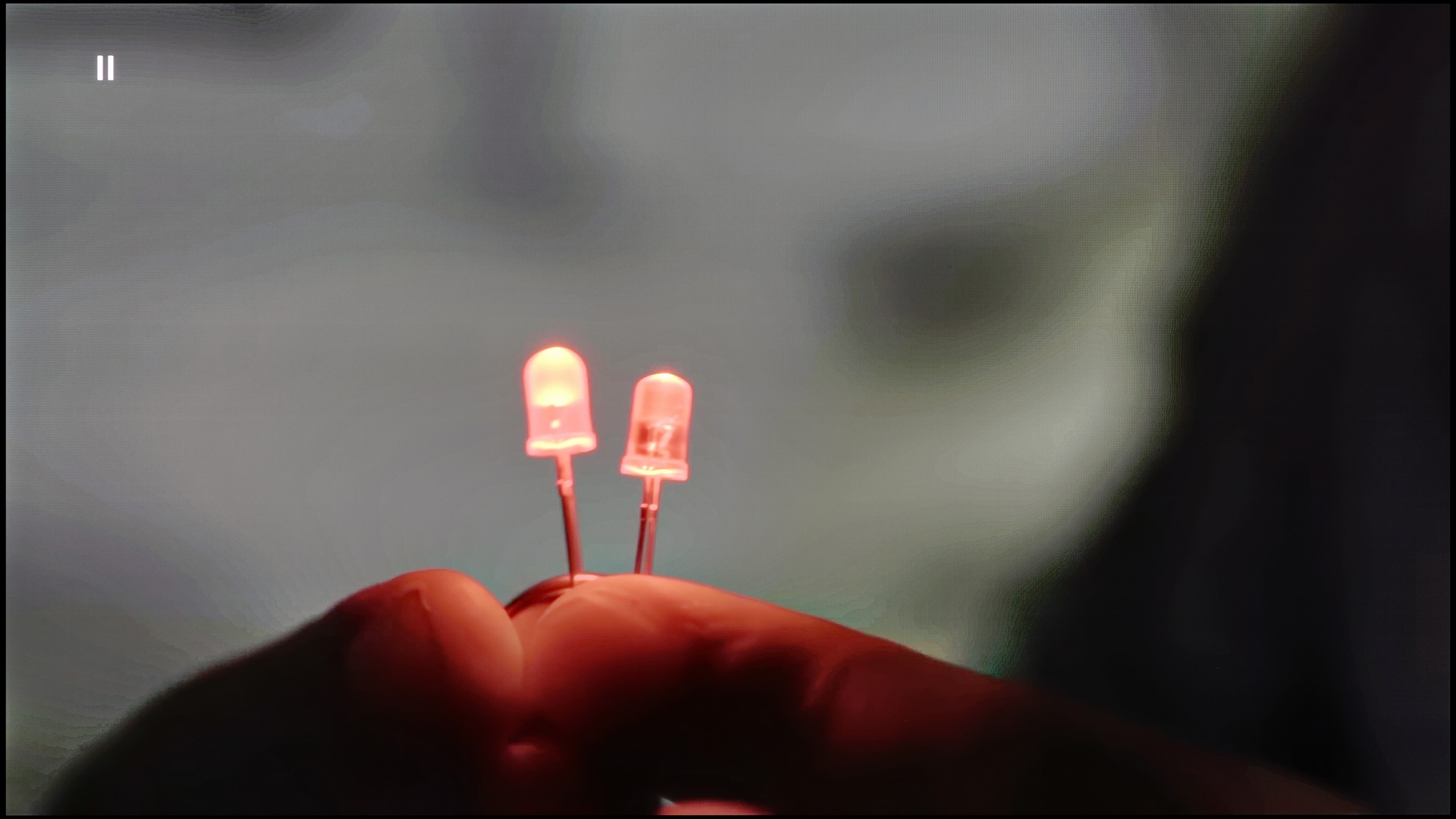
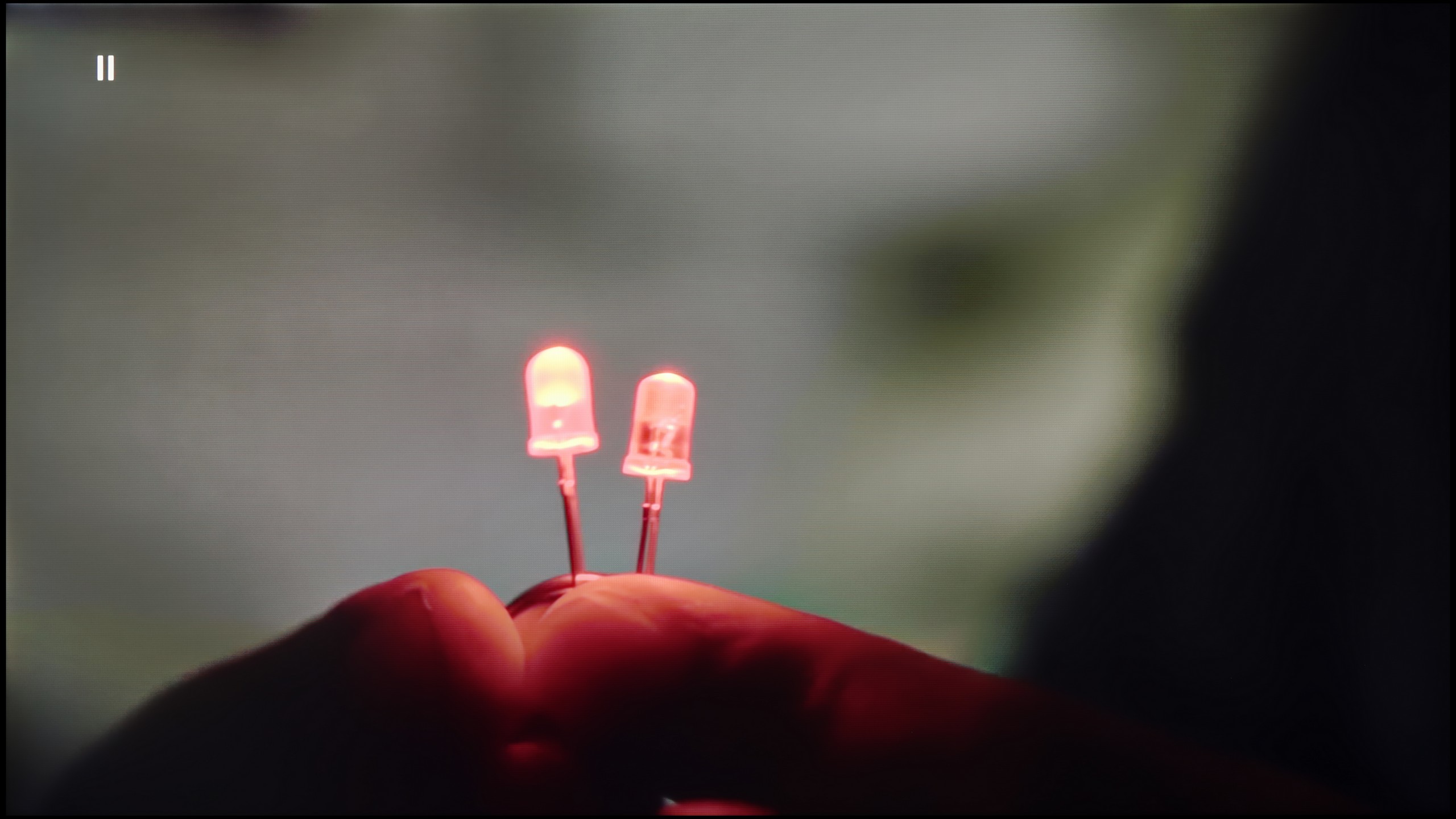
Image without overscan on the SD signal

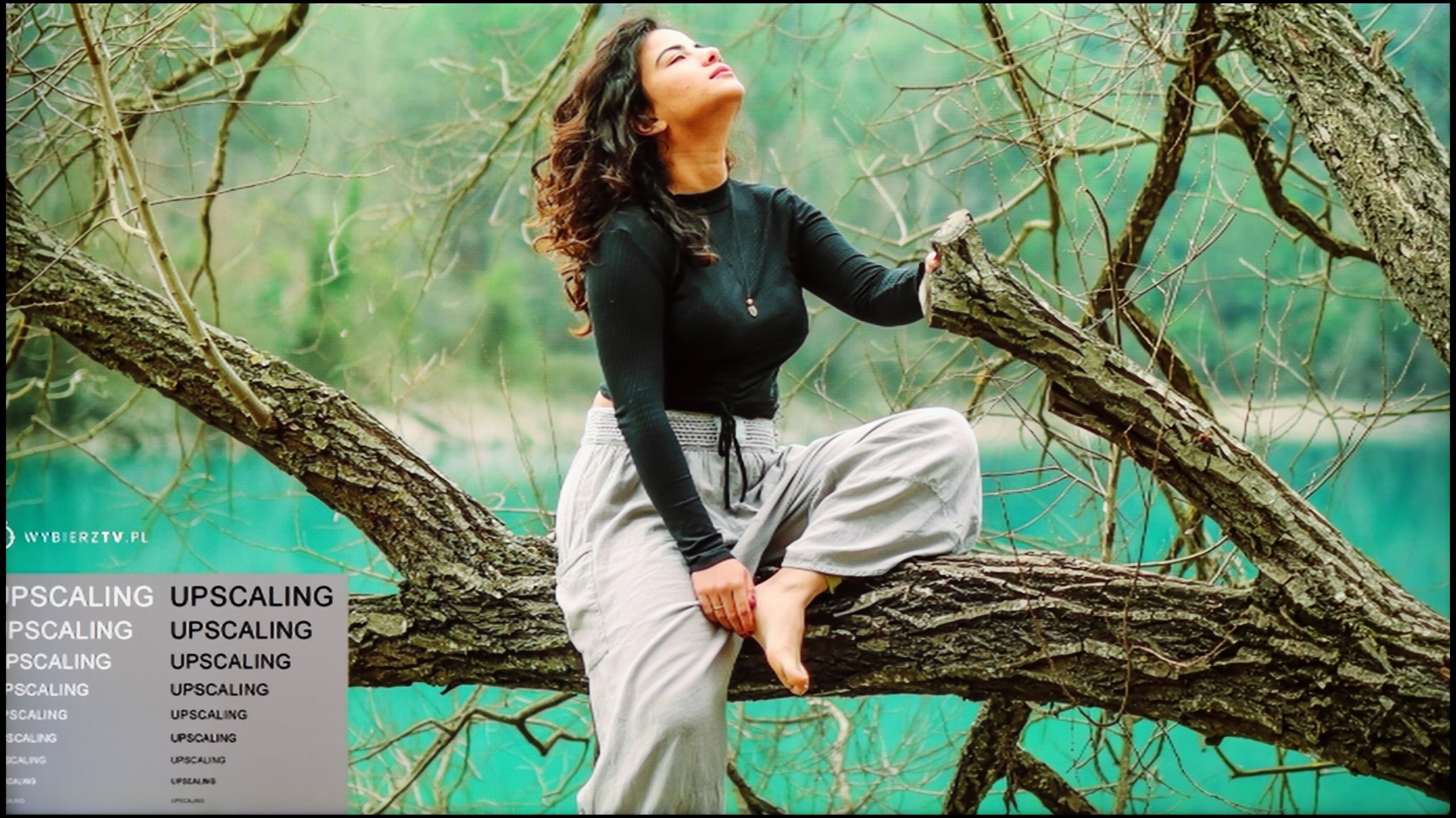
LG B5 really surprised us positively in terms of dealing with lower quality content. Thanks to the enhancement and smoothing features, HD or even SD materials get a new life. Importantly – when this option is turned on at the "low" or "medium" level, we don't get the impression that the image is artificially softened or overly smoothed. Details remain intact, film grain does not disappear, and object edges do not look washed out 😉. It's a really useful tool – especially if you watch terrestrial TV, archival materials, or content from YouTube in lower resolutions. The image is clean, cohesive, and simply pleasant to the eye.
Upscaling as such works very well – even content of poor quality is rendered with surprising fidelity. Unfortunately, there was a small hiccup. While the menu offers an option to turn off overscan, the television still struggles to display very low-resolution images correctly. It’s a minor detail, but when watching older materials – it can be annoying.
While the smoothness of tonal transitions in 4K HDR content on The Frame Pro is not a problem at all, naturally with weaker signal quality – from television, HD content, or older Full HD films – imperfections may occur. Therefore, it is crucial how the television handles these limitations thanks to its image processor. The noise reduction feature works really effectively here. At the medium setting, it eliminates unwanted bands or artifacts, smoothing the image in a noticeable but not overly exaggerated way. However, it should be noted that Samsung tends to operate aggressively – even at the lowest setting of this feature, it can "eat" film grain. It is therefore advisable to use it with caution and adjust the settings to the material being viewed.
The upscaling itself is at a high level. The Frame Pro can effectively upscale older materials to native 4K resolution while maintaining good sharpness and readability. Movies and series in lower quality simply look better here. However, it is worth mentioning a minor drawback – typical for many Samsung televisions. With very old sources of poor quality, you may notice cropping of the image edges on the left side of the screen. This is not a problem that will ruin the viewing experience, but it is good to know that it may occur.
Blur and motion smoothness
8.5/10
7.8/10
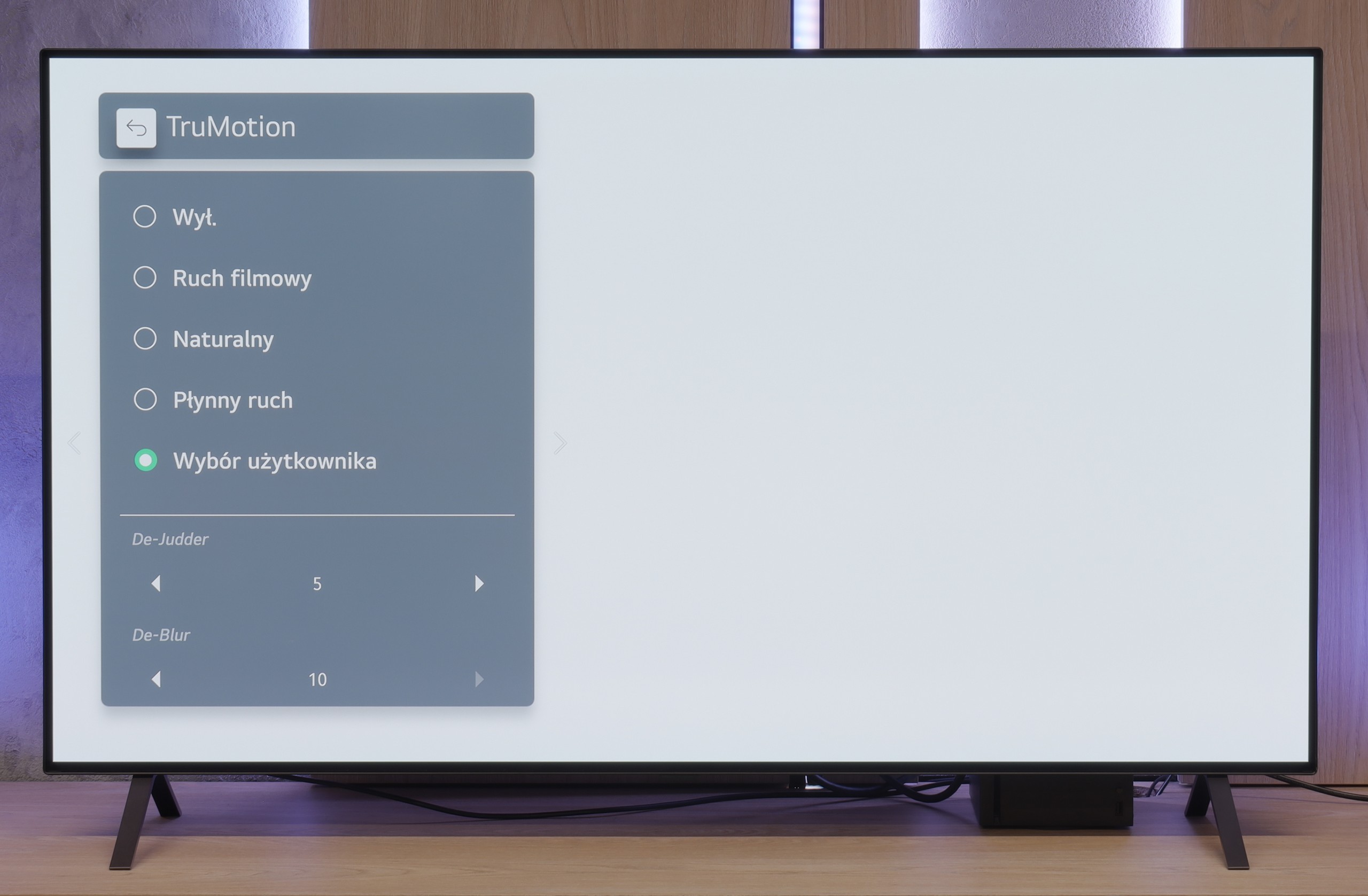
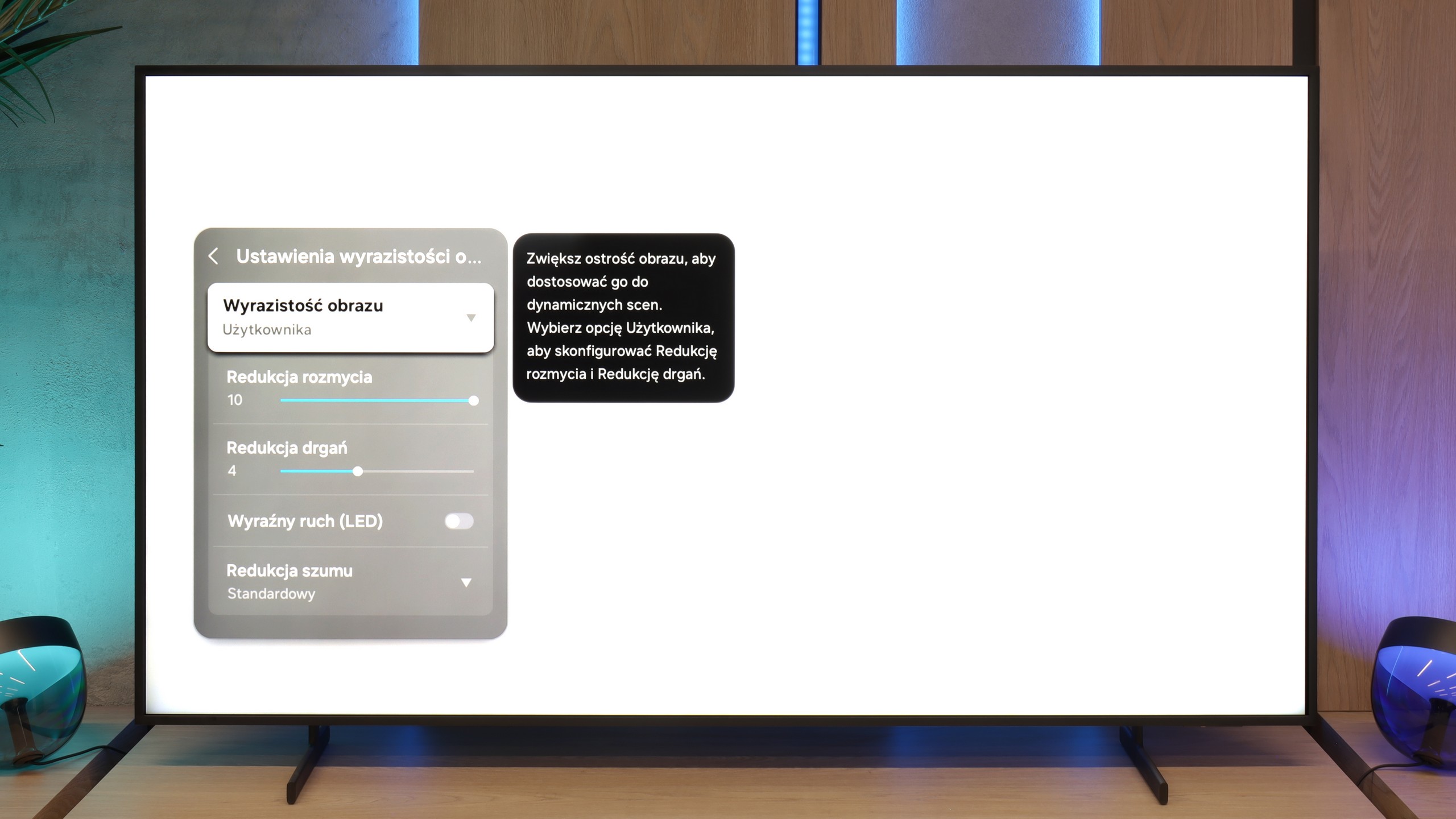
Blur (native resolution, maximum refresh rate):



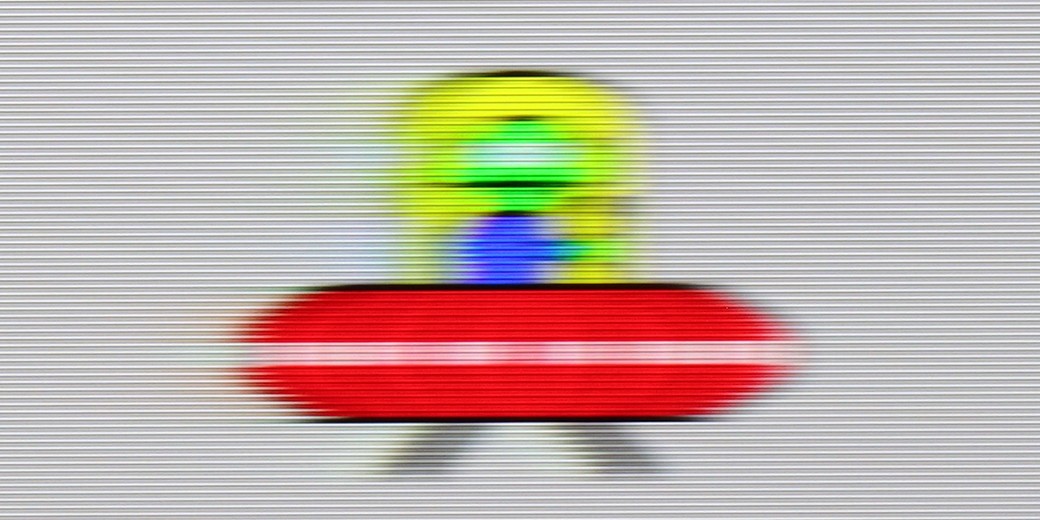
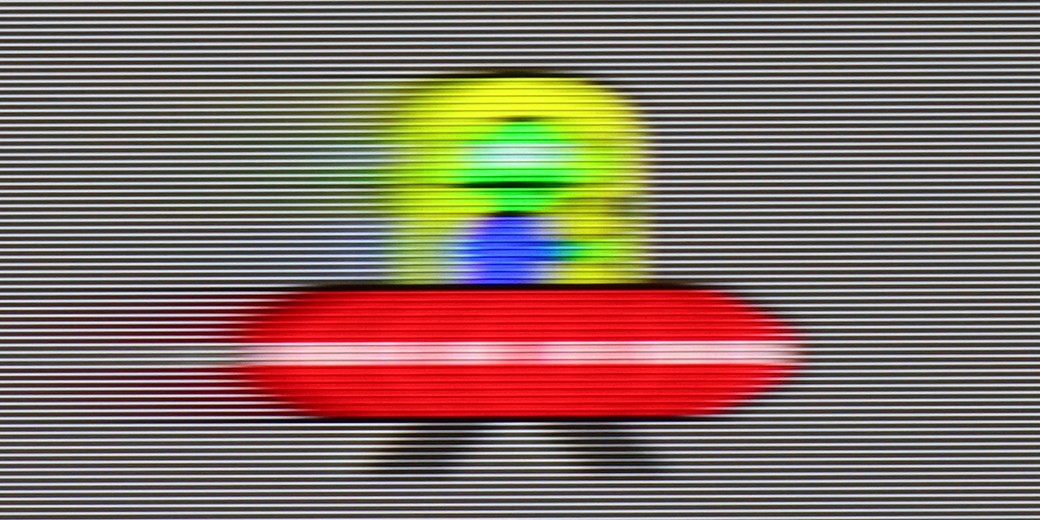
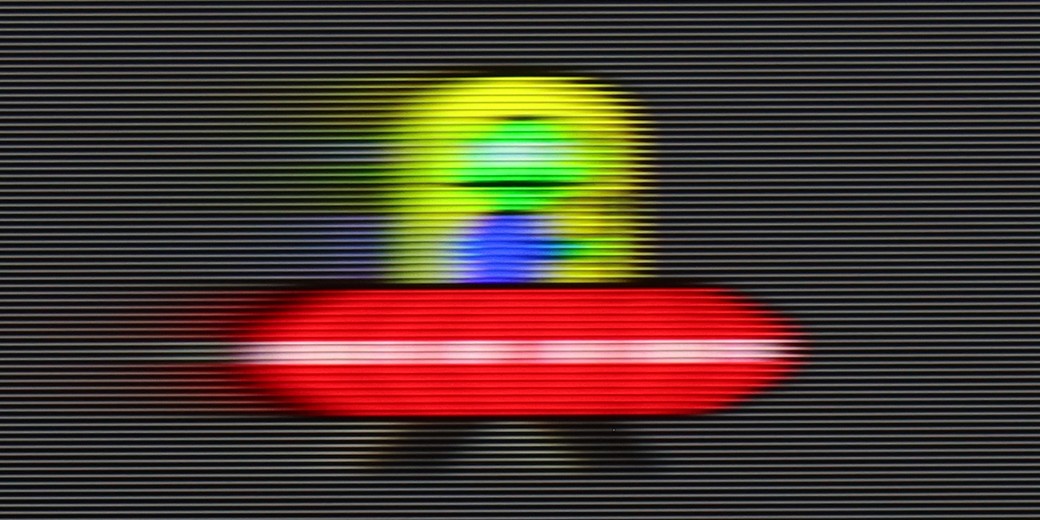
Blur (BFI function enabled):
Image flickers in this mode



Smużenie ():
Smużenie (4K@144Hz):
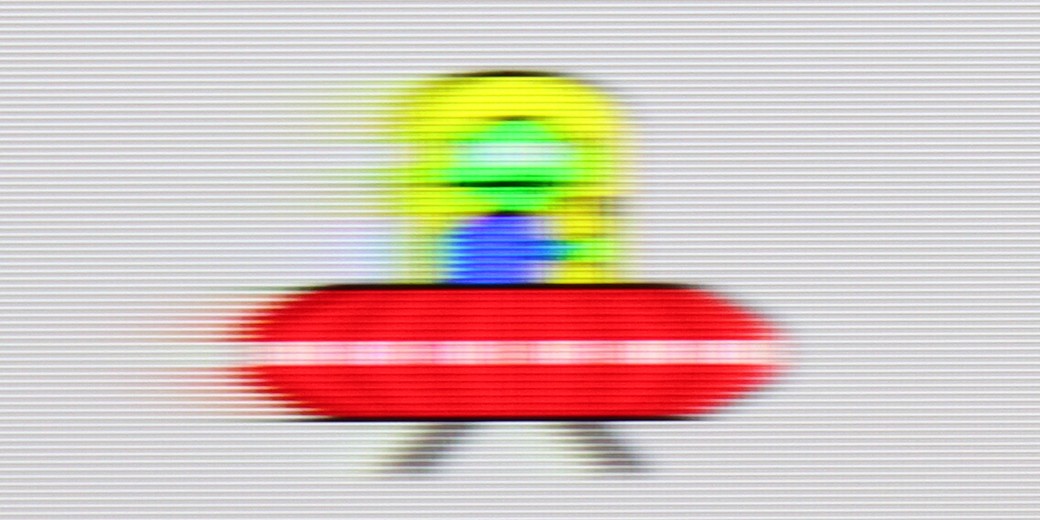
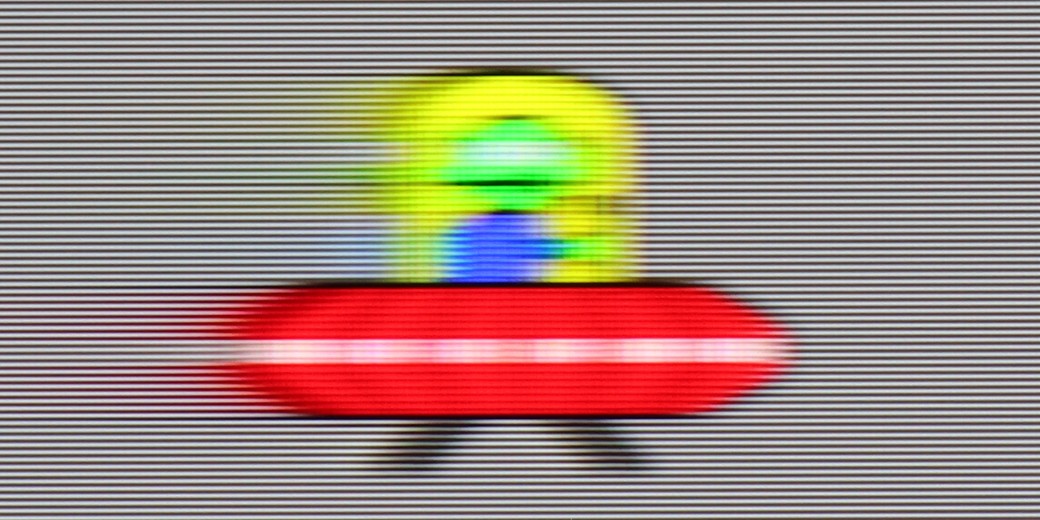
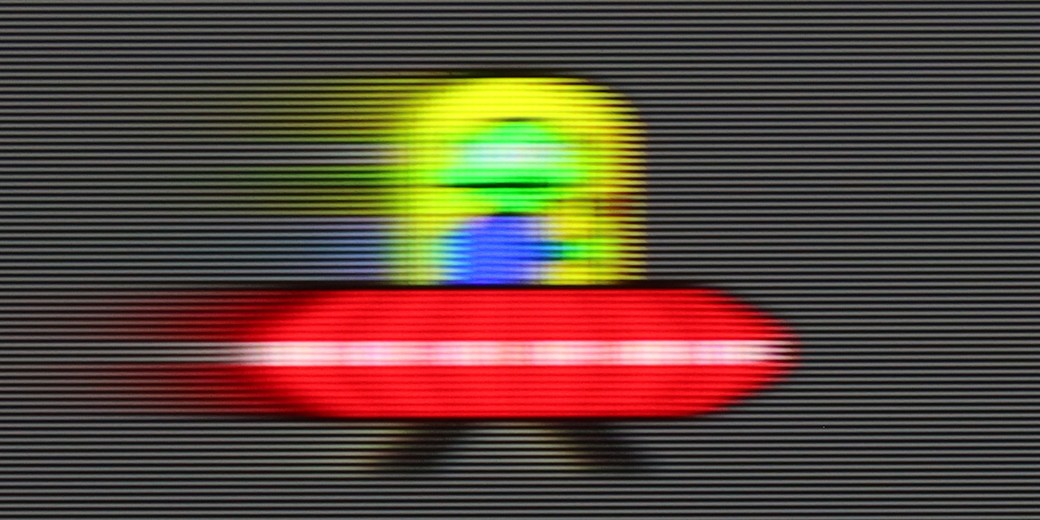
The LG B5 is a television with a 120 Hz OLED panel. It may not sound as impressive as the marketing terms "144 Hz" or "165 Hz" found in gaming monitors, but honestly? The smoothness is still excellent. The picture is sharp, smooth, and simply enjoyable to watch – even when there’s a lot happening on the screen. The organic panel does its job – the pixel response time is nearly instantaneous, which means there’s no blurring or smearing that can ruin dynamic shots. Sports, fast-paced games – everything looks clear and distinct.
We also have LG's classic motion smoother, TruMotion. This feature allows you to smooth out films shot at 24 frames per second – in other words, most of what you watch on Netflix or on Blu-ray discs. If you set the “De-Judder” slider to lower values, you'll get an image closer to the cinematic experience – with a slight judder, but without artificiality. Higher settings? Soap opera effect guaranteed. Fortunately, LG gives you the choice, and you can tune everything as you like.
The smoothness of motion in The Frame Pro is ensured not only by the panel, which operates with a refresh rate of up to 144 Hz, but also by the image processor and the smoothing system. It is thanks to this that we can adjust the way we display movies or sports broadcasts to our own preferences. Available are sliders for motion blur reduction and judder reduction – the first function improves the sharpness of fast movements, while the second allows for softening the "jumping" image effect during camera pans. Therefore, everyone can choose between a cinematic character of motion and a smoother, more "television-like" style.
Console compatibility and gaming features
10/10
8.2/10
- ALLM
- VRR
- VRR range40 - 120Hz48 - 144Hz
- Dolby Vision Game Mode
- Correct implementation of HGIG
- 1080p@120Hz
- 1440p@120Hz
- 4K@120Hz
- Game bar
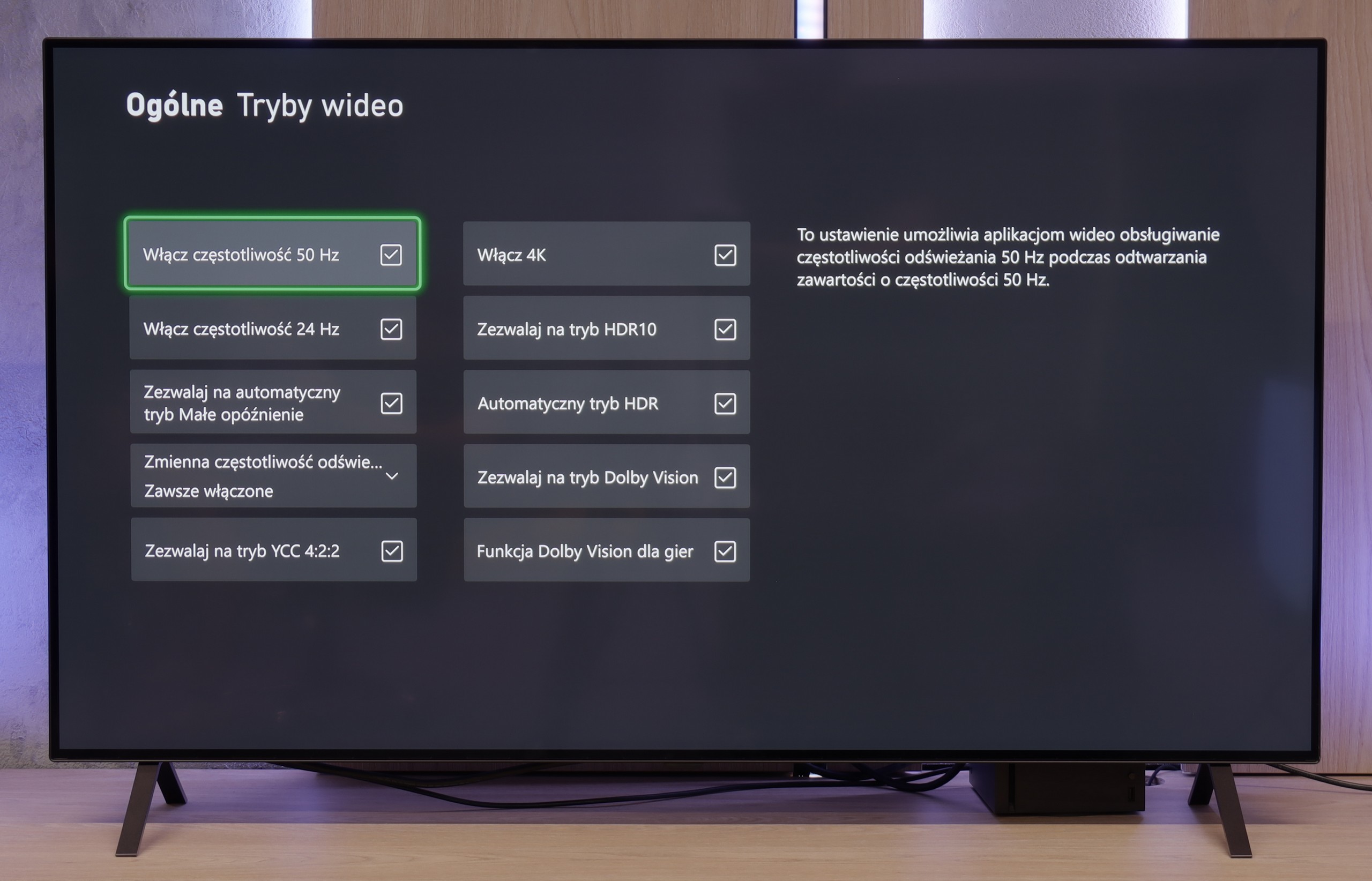
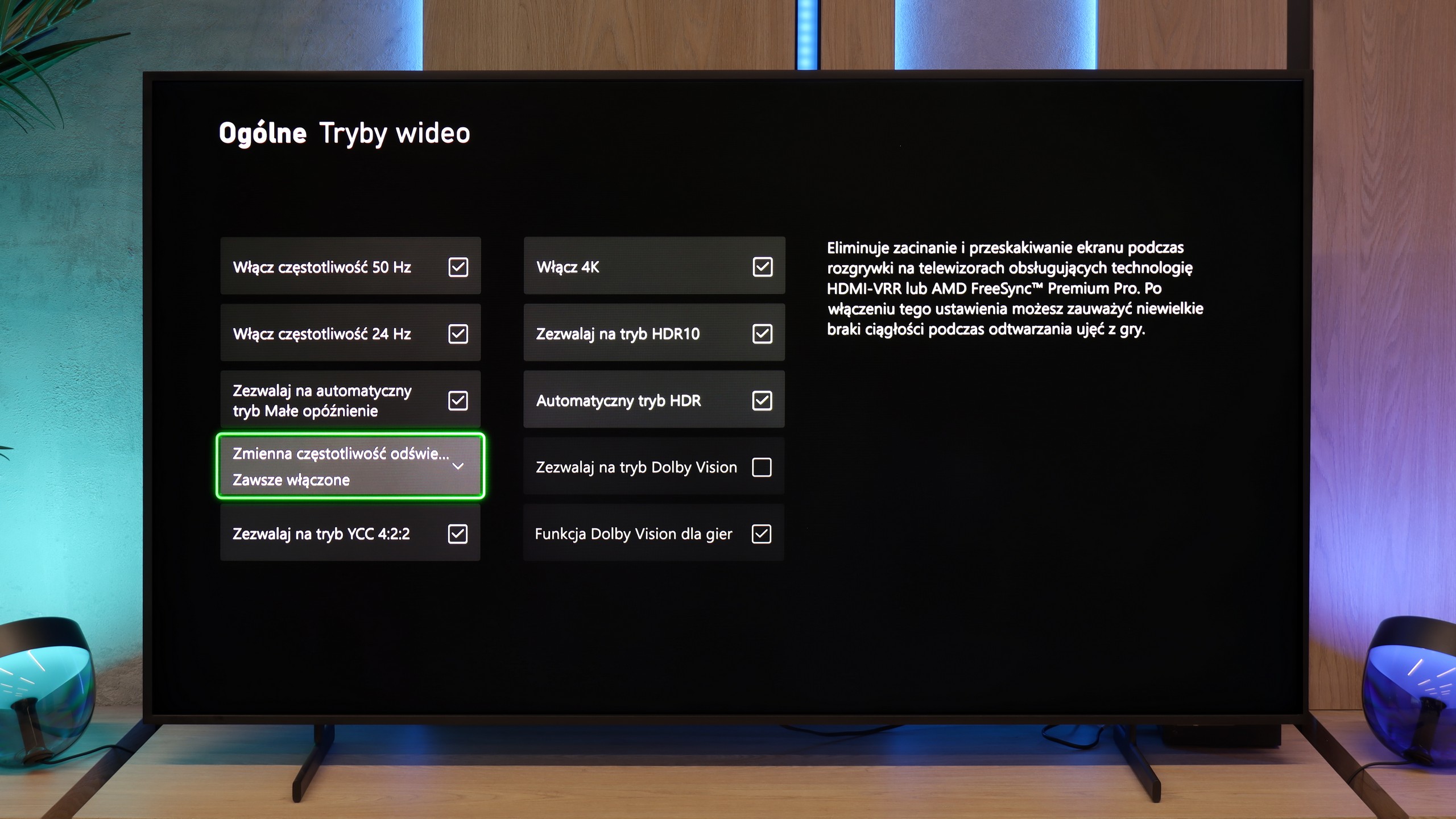
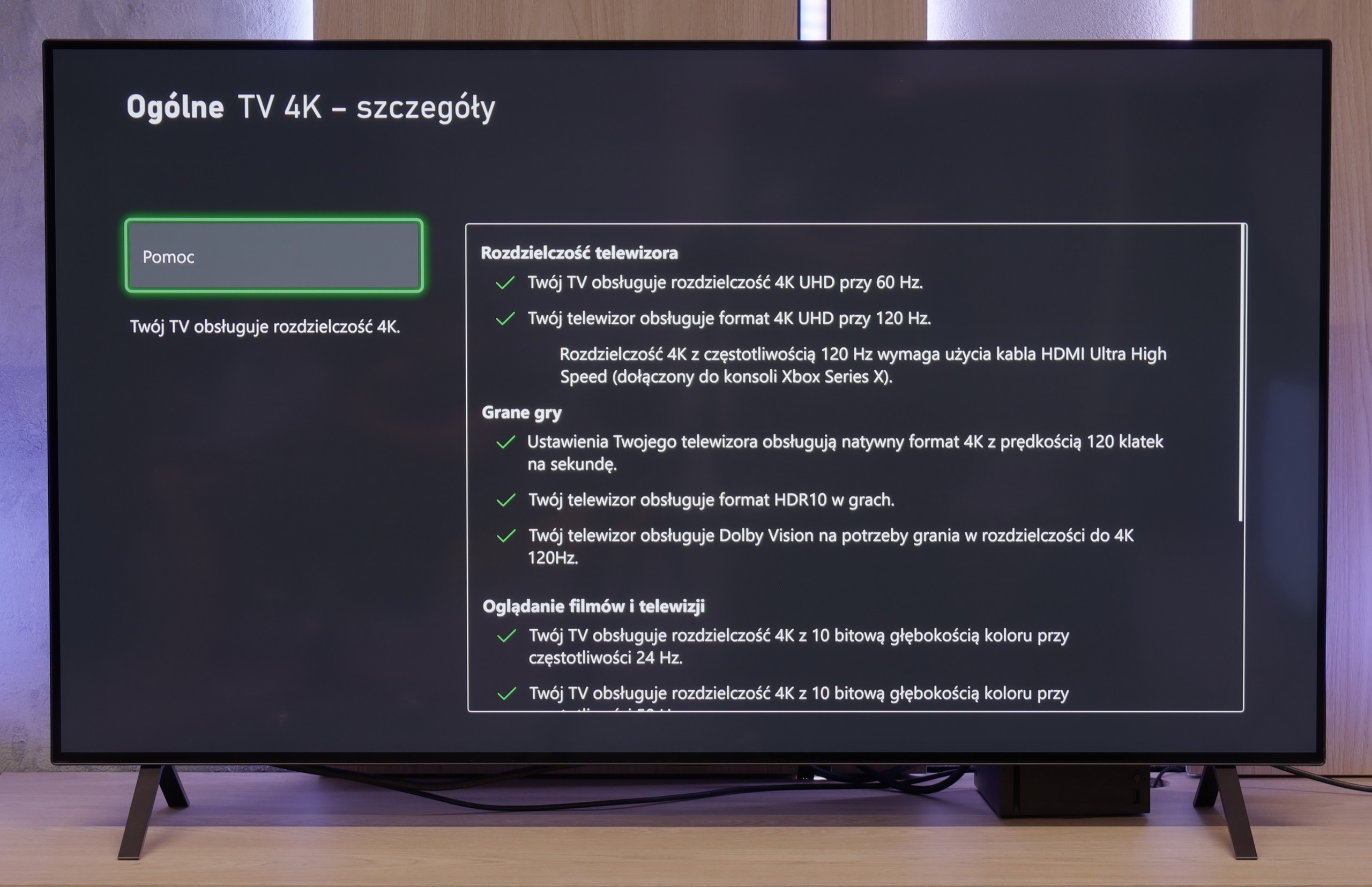
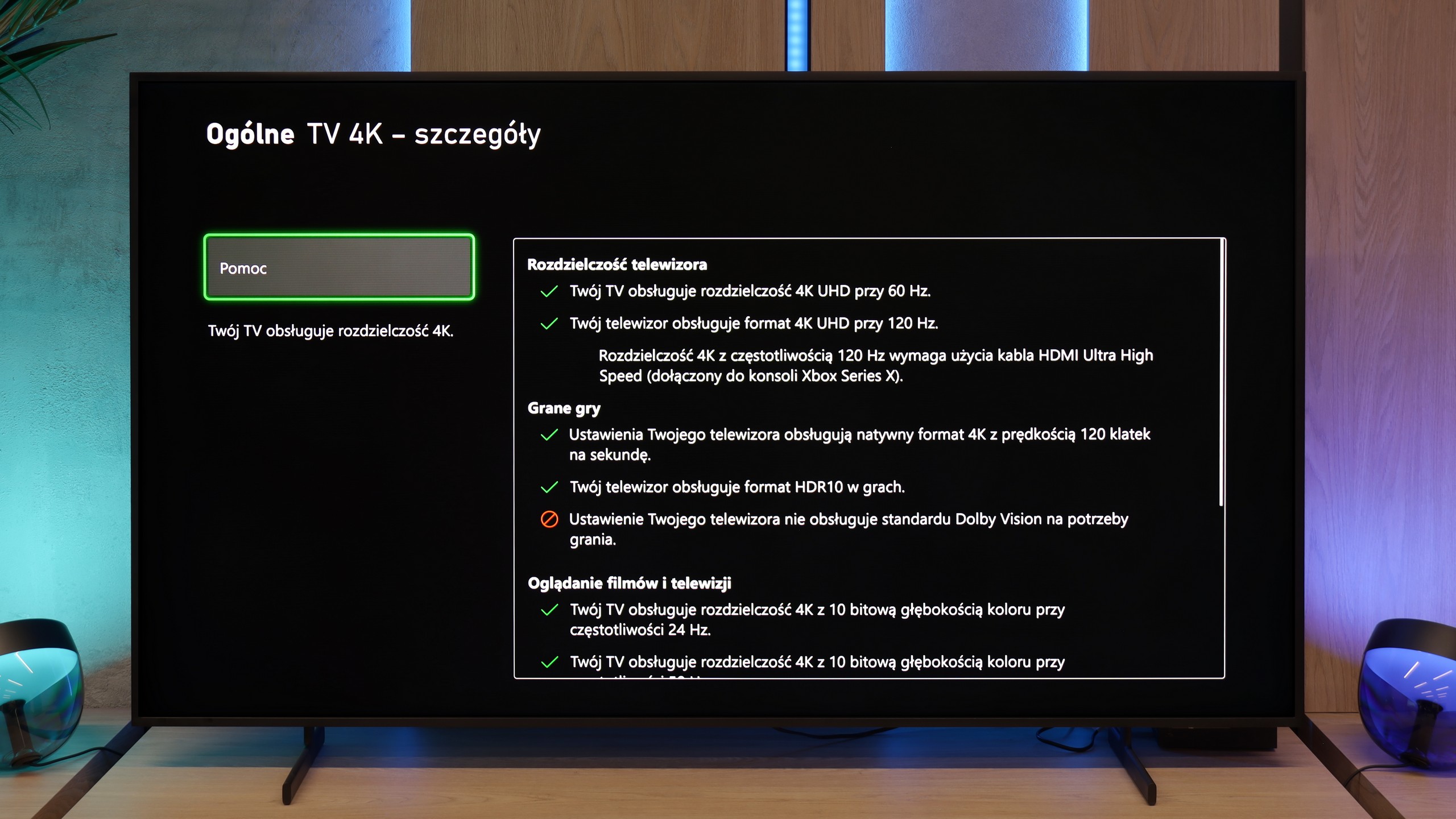
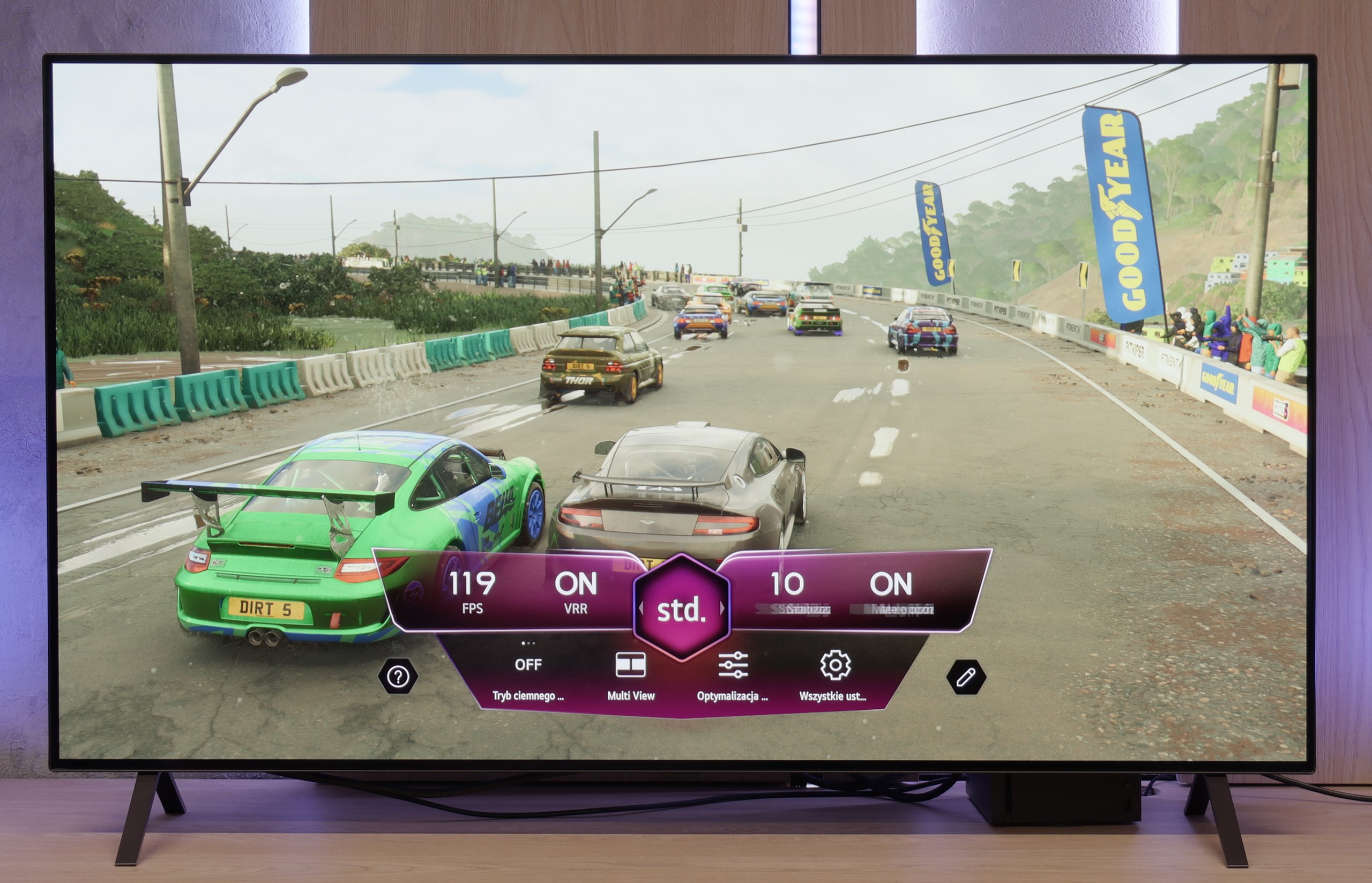
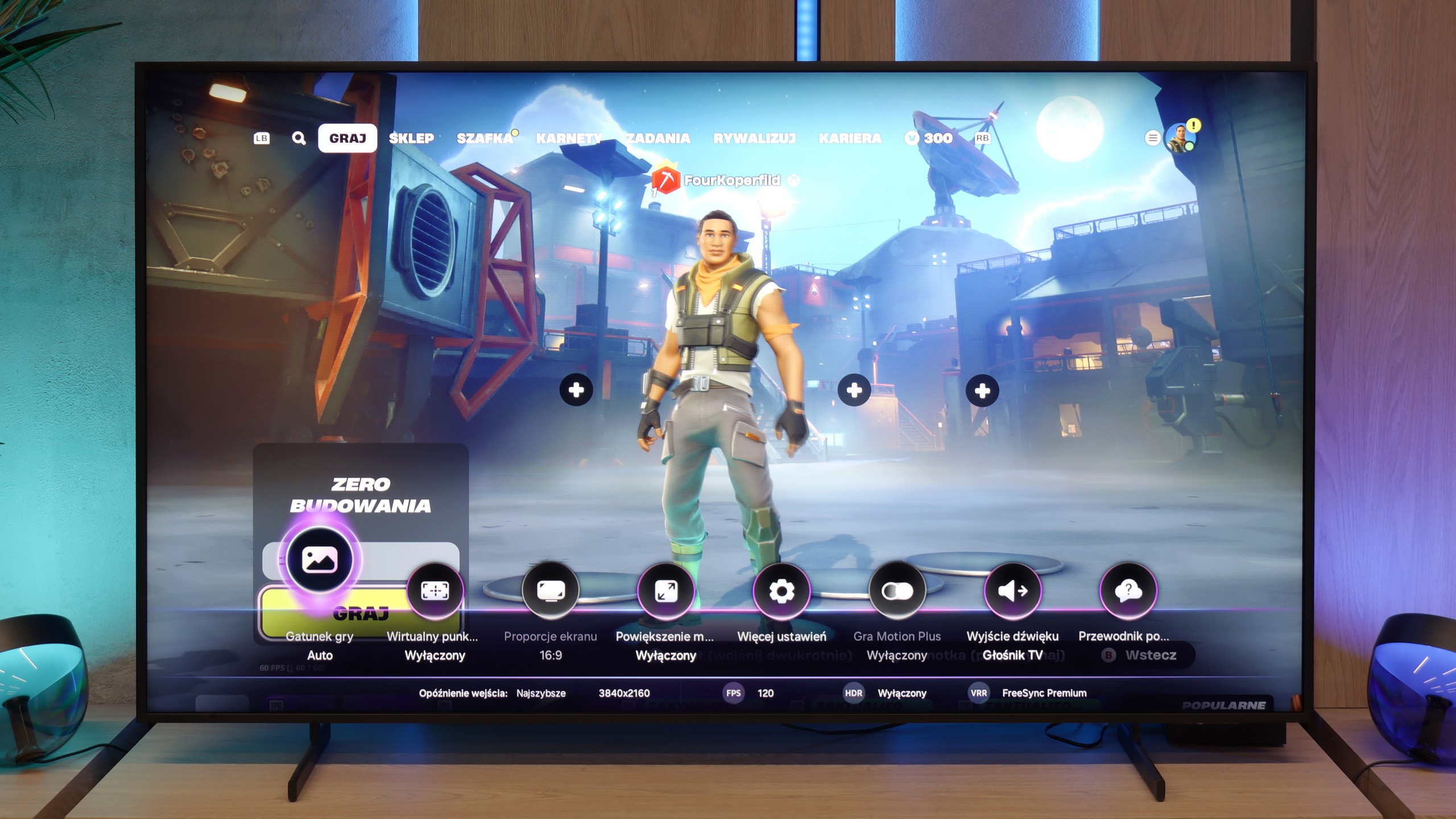
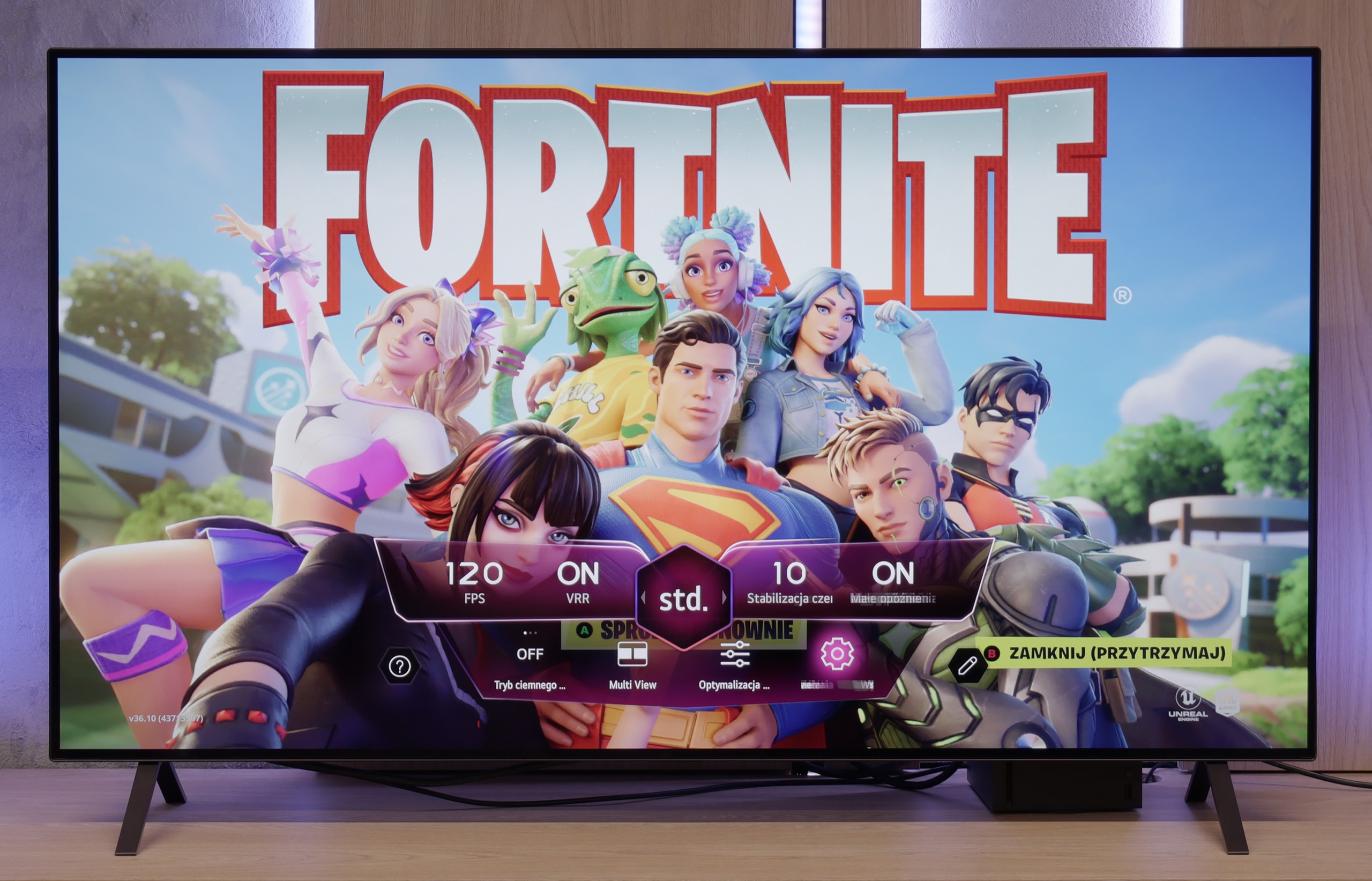
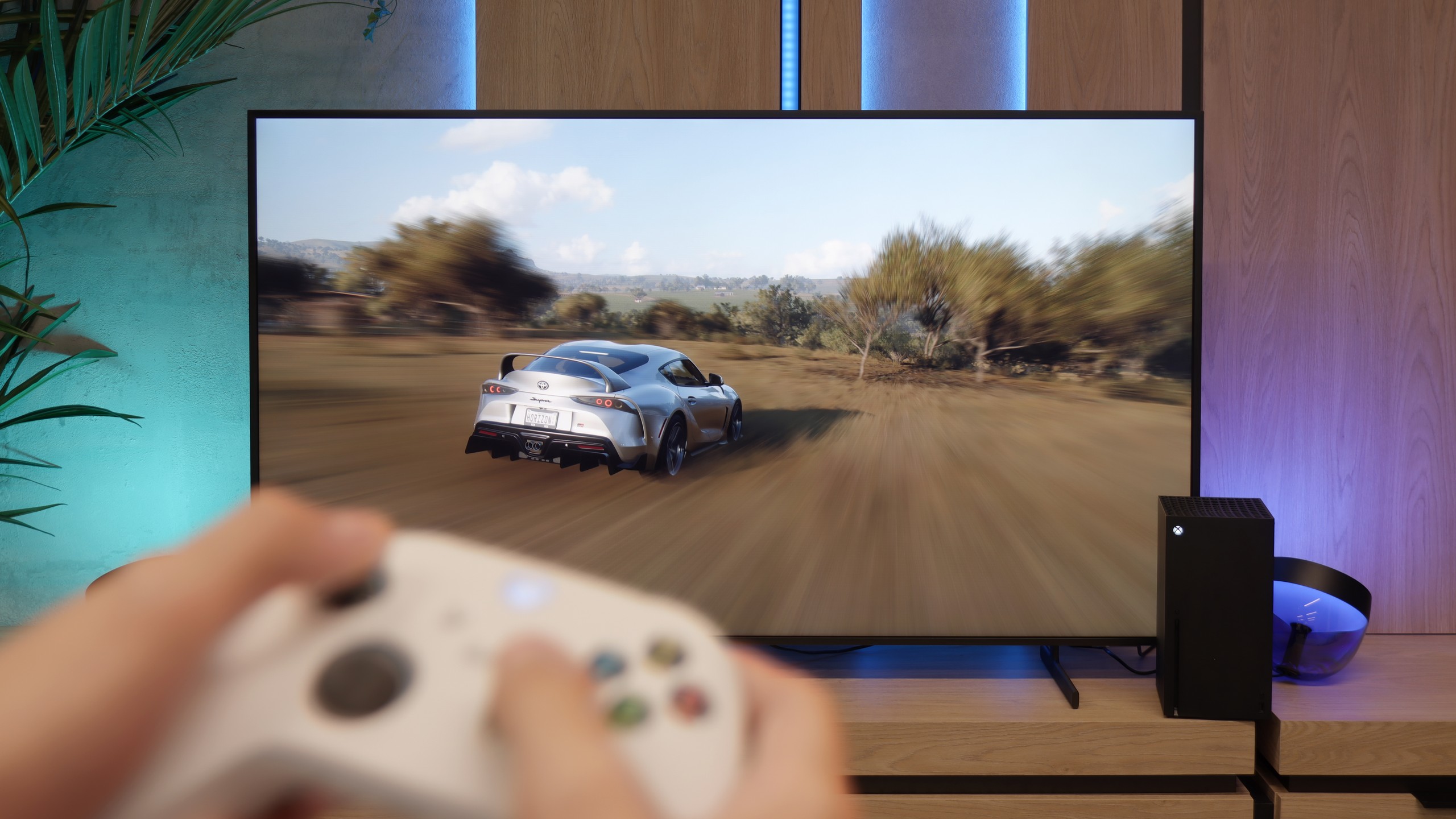
There are already a few televisions on the market with the label "for gamers" that don’t really understand what that means. The LG B5 is not one of them. Everything here is right – there are four HDMI 2.1 ports, it has 120 Hz, VRR and ALLM, and it also has a Game Bar that is actually useful, not just looks good in the promotional folder. You connect your console – it works. You set 4K at 120 Hz – it works. You have an Xbox and want to play in Dolby Vision – it works too. And not in the sense of "it theoretically supports it," but rather it really turns on, looks good, and you don’t have to fiddle with the settings for half an hour. On top of that, there’s the HGiG picture mode, which LG has implemented correctly – meaning that HDR in games doesn’t turn the screen into a flashlight but shows exactly what it should. There are no surprises here, no strange limitations, no "buts." And you know what? That’s how it should be. Kudos to the LG B5!
Samsung The Frame Pro doesn’t pretend to be just a “living room” television; here, gamers will also find something for themselves. The manufacturer has ensured a full suite of gaming features: we have support for variable refresh rate (VRR), automatic low latency mode (ALLM), refresh rates up to 144 Hz, and compatibility with both G-Sync and FreeSync Premium Pro. Additionally, there’s the well-known Game Bar panel, which is a quick menu where you can check key parameters on the fly – from refresh rates to active image processing modes. Are there any downsides? Yes, The Frame Pro doesn’t support Dolby Vision in gaming mode, but it's hard to consider this a serious issue – most gamers use HDR10 anyway... so, the HGIG mode. Exactly. The biggest surprise turned out to be the latest software update. Samsung… completely removed this option from The Frame PRO. In practice, this means that the TV independently interprets HDR tone mapping in games, and the user has no ability to enable settings designed for consoles. This is a step backward that may disappoint more informed gamers expecting full compliance with HGiG guidelines. We just hope that this mistake will be quickly corrected.
Interestingly, The Frame Pro also features an atypical arrangement of HDMI 2.1 ports. We have as many as five available – four are located in the One Connect module, and the fifth, in micro HDMI version, is directly on the TV. This solution is quite unconventional, but very practical. Samsung clearly suggests that this is the port to connect your console or computer. Why? Because it minimizes potential delays associated with communication through the wireless One Connect, and in gaming, every millisecond matters. We wrote separately about input lag, but it can be revealed here that by connecting equipment directly to the TV, we achieve the absolute maximum response speed.
Input lag
9.9/10
9.9/10
SDR
HDR
Dolby Vision
Here, we won't elaborate – the LG B5 simply has fantastic input lag. For 60 Hz content, it scores below 10 ms, and for 120 Hz, it even drops to around 5 ms. These are values that you can't honestly complain about. It just works instantly, without delays, without surprises. Well… almost. Because as usual, there's a small asterisk with the Dolby Vision Gaming mode. In this mode, the response time slightly increases. It's nothing dramatic – these are still very low values, rather imperceptible while gaming – but if you're playing exclusively tournament titles and fighting for every millisecond on the XBOX, it's worth keeping in mind.
The Frame Pro in wired mode achieves truly excellent results. Latencies range from 9 to 14 ms, ensuring smooth and instant reactions in games. These are values that can easily be considered reference – even in dynamic titles, the action unfolds without delays, and the controls are precise and predictable. The situation changes when the wireless One Connect module comes into play. While it allows for hiding cables and enjoying greater freedom of room arrangement, it significantly worsens input lag results. In tests conducted at a distance of 2 to 3 meters from the television, with no furniture obstacles, the values jumped to as high as 50ms. While this is acceptable for watching movies since input lag doesn’t concern us at all, it becomes problematic in games and greatly spoils the experience. It’s somewhat of a paradox – on one hand, we have a television that offers some of the best results on the market in wired mode, while on the other hand, Samsung promotes a solution that proves quite detrimental for gamers. And after all, the console is one of the key devices we usually connect to the television...
For the sake of order, we present our wireless measurements at a distance of 2-3m:
SDR | HDR |
|---|---|
1080p60 Hz: 39 | 2160p60 Hz HDR: 40 |
1080p120 Hz: 25 | 2160p120 Hz HDR: 25 |
2160p60 Hz: 40 | |
2160p120 Hz: 25 |
Compatibility with PC
7.6/10
8.4/10
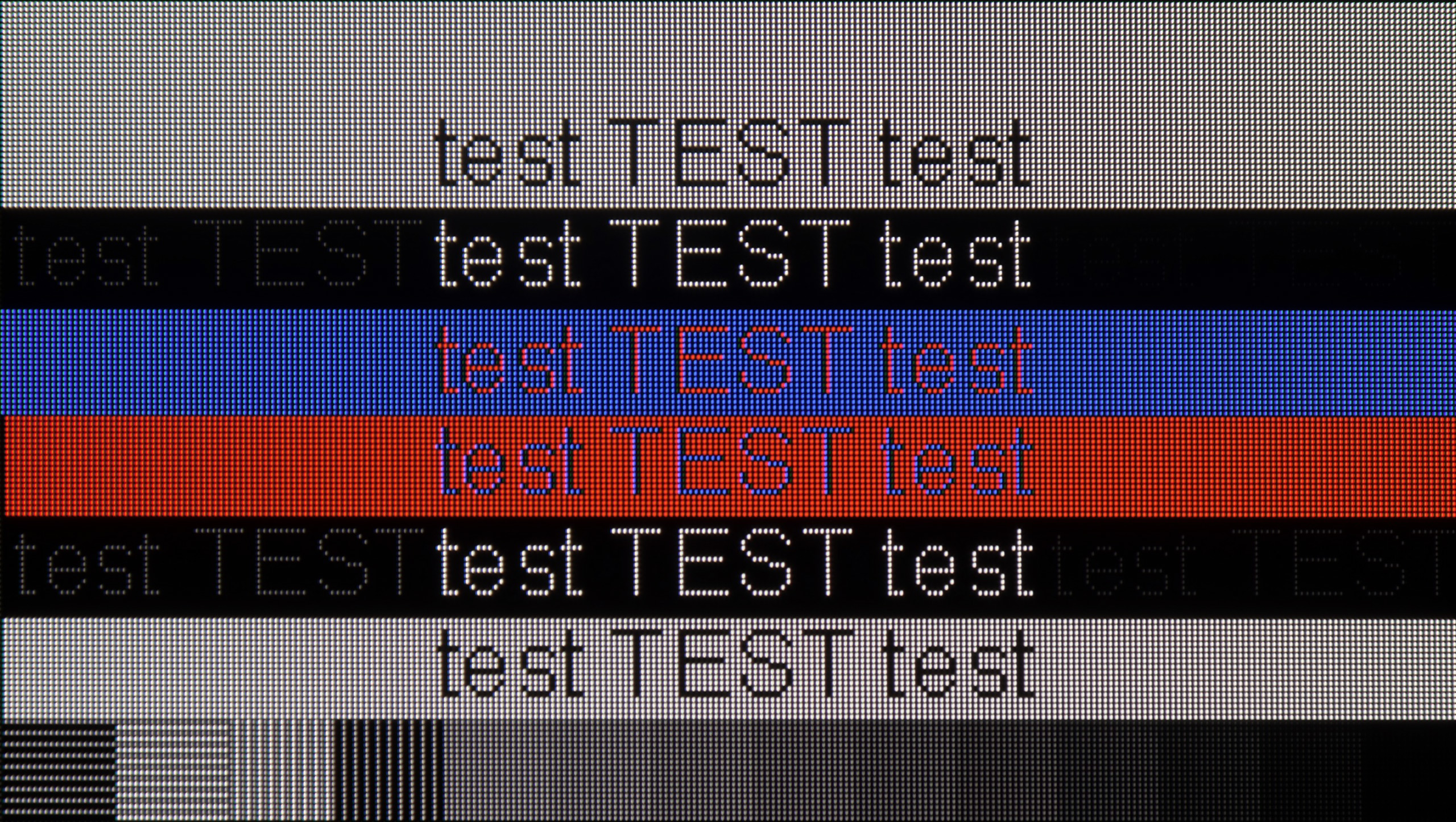
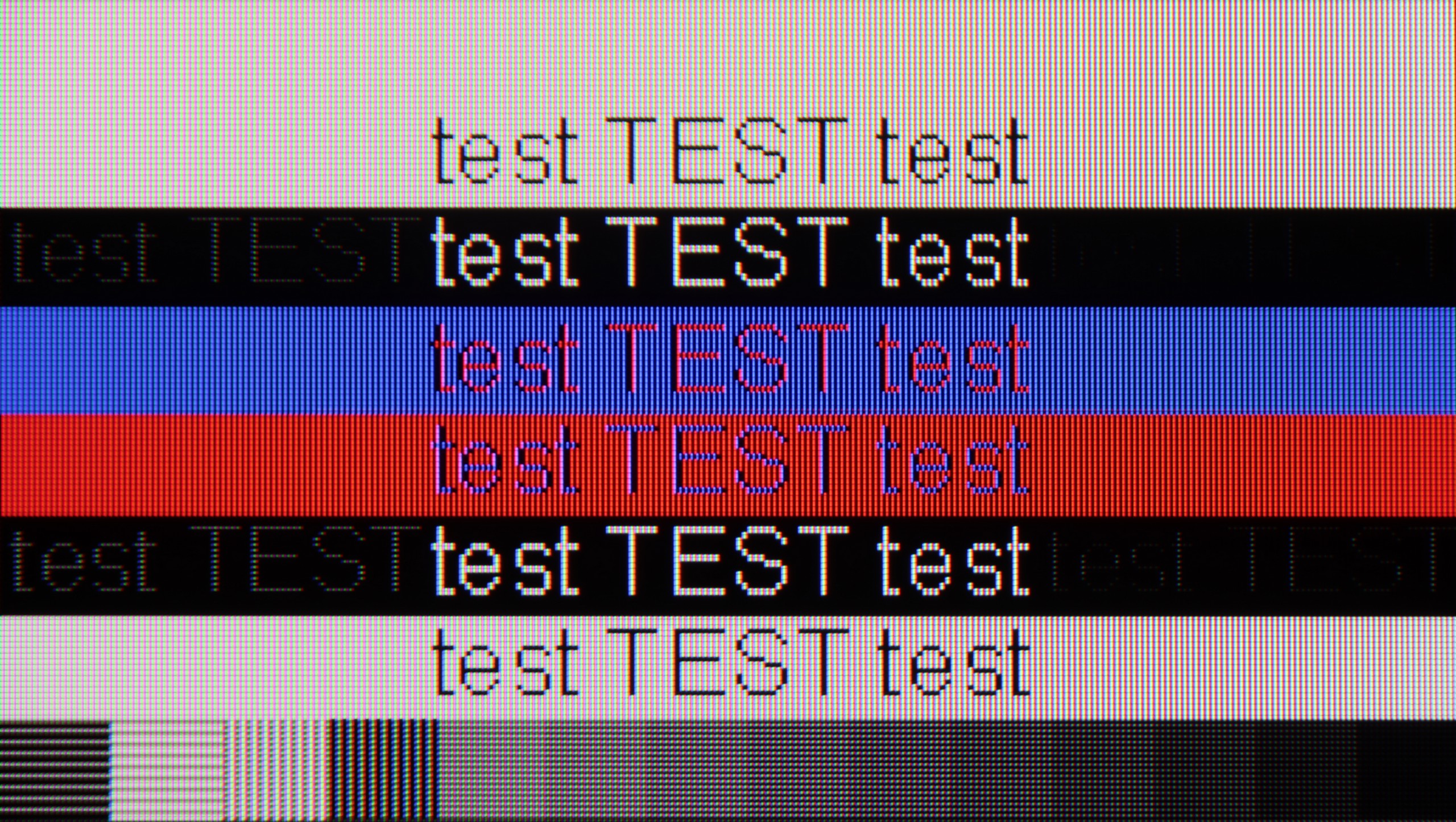
LG B5 is a TV that works great with a computer. You won't find gaming features like 144 or 165 Hz here, but is that really necessary for anyone? With a 120 Hz panel, low input lag, and G-Sync support, it’s truly a very good screen for gaming on PC. No stuttering, no tearing, with lightning-fast response.
But it’s not just for gaming. You can also quite comfortably... simply work on the B5. The TV correctly supports chroma 4:4:4, so fonts are readable, interfaces are clear, and your eyes won’t hurt from blurred letters. This is not obvious, even among more expensive models. However, there is one “but” – and this applies not only to the B5 but to every OLED with a WOLED panel. The RWGB subpixel layout can cause a slight shadow at the edges of fonts. This is not something that stands out from the couch. It’s more likely to be noticed by someone sitting with their nose to the screen and spending half the day in Excel.
Connecting The Frame Pro to a computer via a wired connection is basically no rocket science – it works as it should. The image is clear, the fonts look good, you can calmly handle everyday work in Word or Excel, and then launch a game and it’s still okay. The real fun begins when we use the wireless module. And this is where the entire paradox of this television comes out again – a solution that was supposed to make life easier in theory can actually make it quite frustrating in practice. It's not just about the aforementioned delays, which can be immediately felt when using the mouse, but also about the clarity of the image itself. The fonts start to look simply worse, at times you can see some kind of delicate stripes, and the letters lose sharpness, and suddenly working with text becomes simply exhausting. And it's really strange that such a simple thing as displaying letters on the screen can fall apart because of the wireless module. So if someone plans to use The Frame Pro with a computer – whether for work or gaming – it’s really worth connecting it via a wired connection right away. Because otherwise, you can become very quickly frustrated, and instead of enjoying the large screen, you’ll feel like your eyes are fighting with the television for every paragraph of text.
Viewing angles
7.4/10
3.1/10
In terms of viewing angles, the LG B5 performs very well – exactly as one would expect from a WOLED panel. No matter from which side you sit, the image retains its quality. The colors do not fade, the contrast does not drop significantly, and the details remain clearly visible. However, it must be honestly added that this is not the level of Samsung Display's QD-OLEDs. They manage to hold color saturation even better at extreme angles. But if you do not plan to watch movies sitting at a 90-degree angle – the B5 is more than sufficient. It’s one of those TVs that simply looks good from every side.
The Frame Pro uses a VA panel, and that immediately means that viewing angles are not one of its strengths. It’s enough to sit slightly to the side to see how the screen starts to lose quality – brightness decreases, colors fade, and blacks that look solid from a central perspective suddenly resemble more dark gray velvet than deep pitch. This is most apparent at about a 40–45 degree angle – there, the image clearly brightens, and color saturation drops significantly. Overall, this is nothing new, as most LCD televisions with VA panels behave this way. At the cost of better blacks compared to IPS panels, we get worse viewing angles.
TV efficiency during daytime
4.9/10
7/10
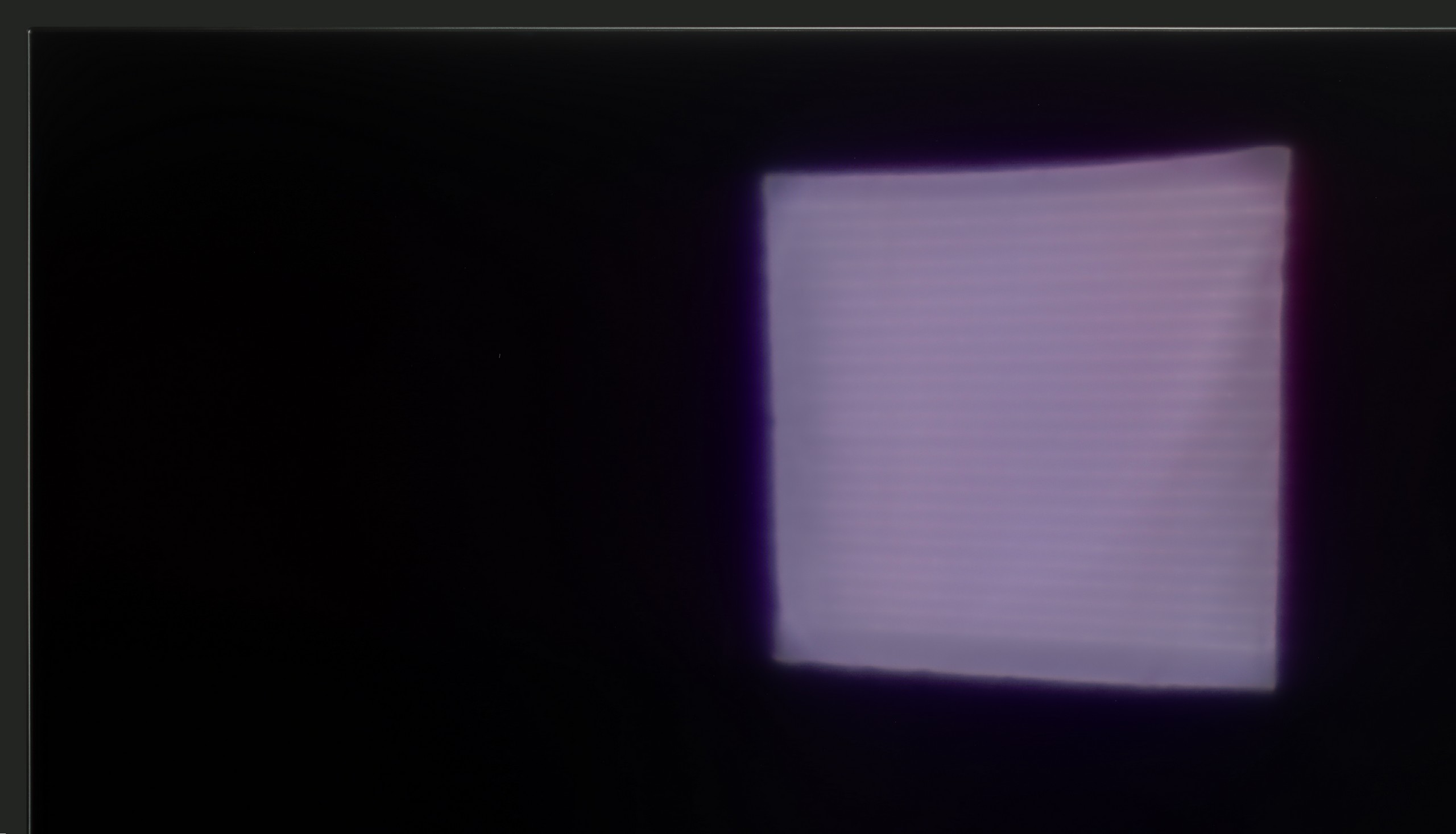
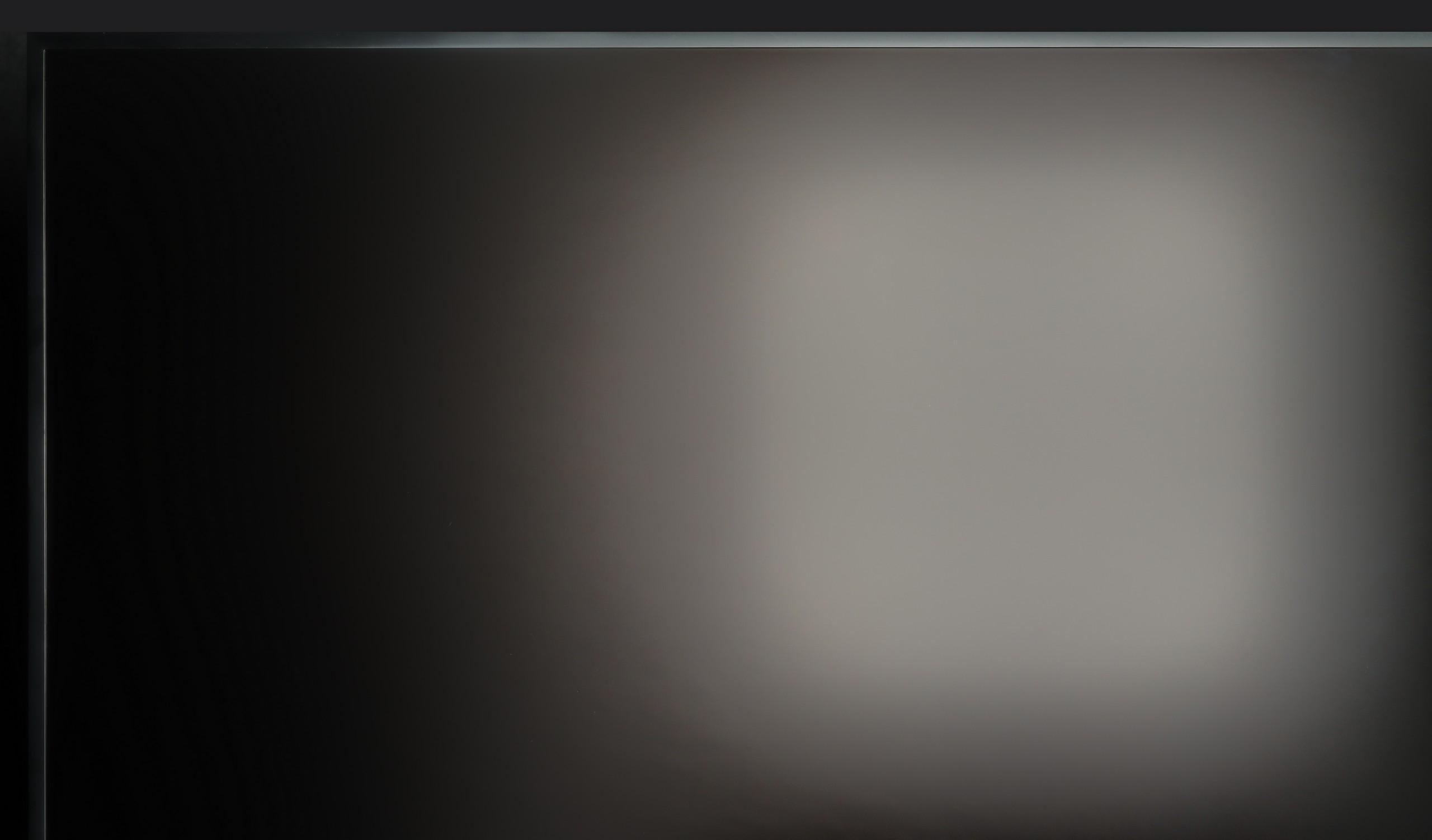


Matrix brightness
Average luminance SDR
Samsung The Frame Pro: 614 cd/m2
LG OLED B5: 279 cd/m2
LG B5 is a television that performs best after dark. But when sunlight comes in, it becomes a challenge. The brightness of this model is rather average, and the anti-glare layer... is also average. There are no special coatings that deal with reflections or very bright daylight. So if you plan to place this television opposite a large, uncovered window – it might just be hard to see anything.
Fortunately, there is something worth praising: the glossy WOLED panel maintains color saturation well. Even in difficult conditions, the image doesn’t fade or become "washed out," as can happen with some television models. Generally, it is watchable, but if you are looking for a television specifically "for a bright living room," then the B5 shouldn't be your first choice.
The Frame series has stood out for almost a few years with its matte display coating, and The Frame Pro from 2025 is no exception. It is precisely because of this that you can be assured that light reflections will not annoy you even in a brightly lit living room. Samsung has refined this technology to near perfection over the years, and today, it can confidently be said that this is the best matte display we can find in televisions. Colors still look good and do not drastically lose saturation, as is the case with cheaper, Chinese designs. Black also remains at a decent level, although it must be admitted that in extremely bright lighting conditions, colors may slightly flatten and lose depth. However, this is a small price to pay for the complete lack of reflections on the screen – and this can be priceless in everyday use. Plus, the brightness must also be noted – about 600 nits in SDR mode makes the picture easily cut through daylight, and it will look satisfactory in most rooms.
Details about the matrix
Subpixel Structure:
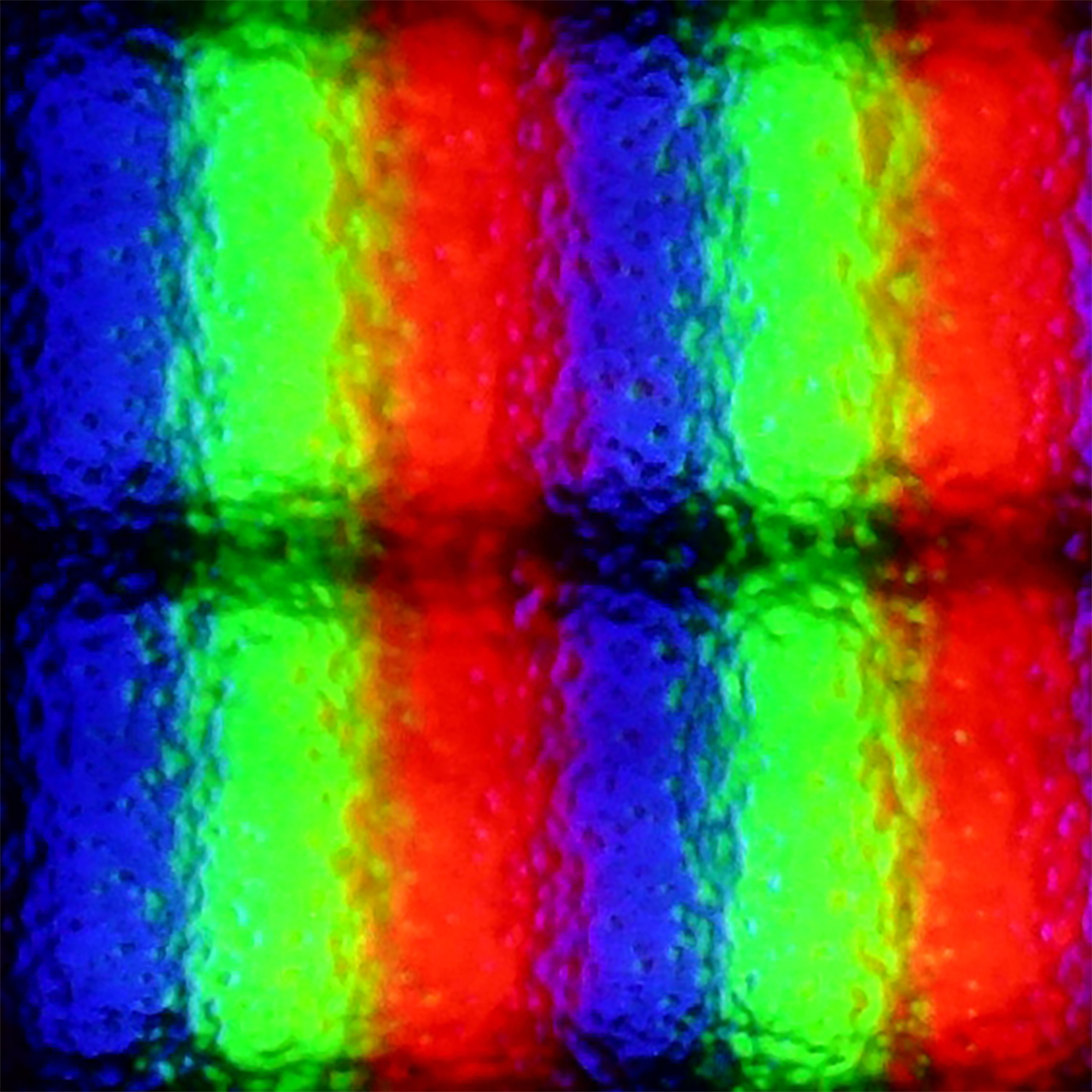
Panel uniformity and thermal imaging:
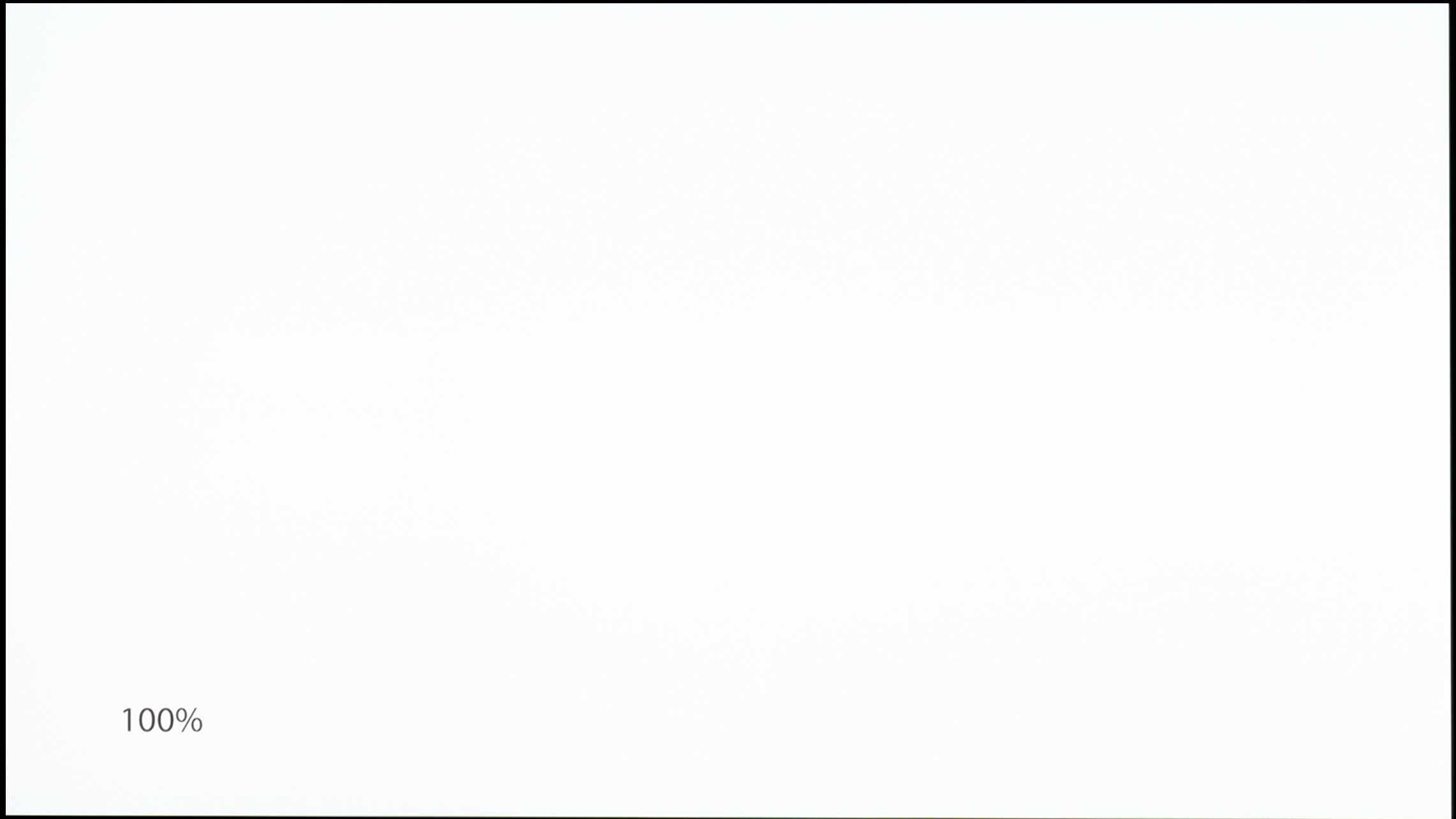
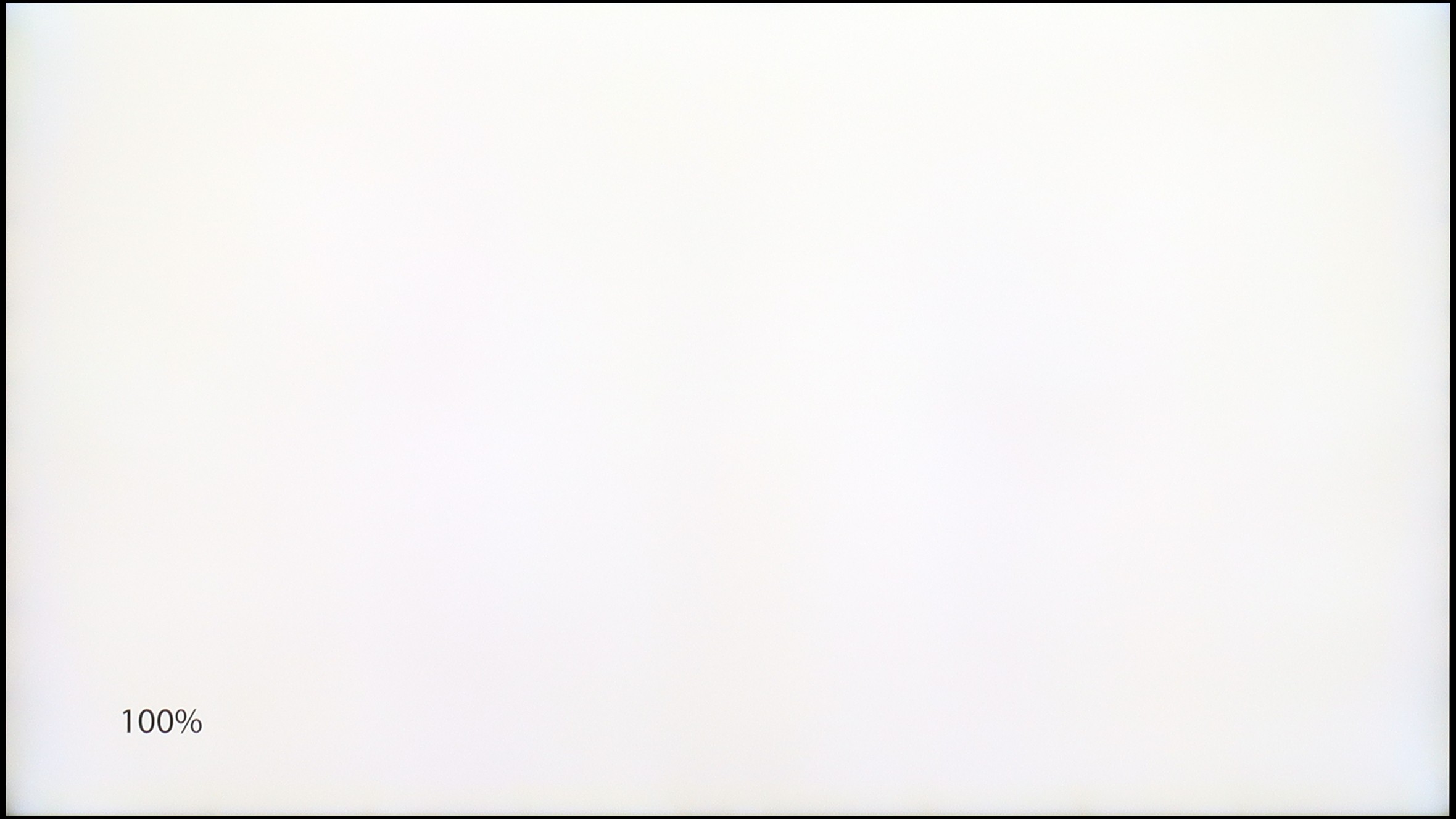
TV features
7.9/10
7.7/10
- HDMI inputs0 x HDMI 2.0, 4 x HDMI 2.1 48Gbps0 x HDMI 2.0, 5 x HDMI 2.1 48Gbps
- OutputsToslink (Optical audio), eARC (HDMI), ARC (HDMI)Toslink (Optical audio), eARC (HDMI), ARC (HDMI)
- Network InterfacesWi-Fi 2.4GHz, Wi-Fi 5GHz, Ethernet (LAN) 100MbpsWi-Fi 2.4GHz, Wi-Fi 5GHz, Ethernet (LAN) 100Mbps
- TV receptionDVB-T, DVB-T2, DVB-S, DVB-S2, DVB-CDVB-T, DVB-T2, DVB-S, DVB-S2, DVB-C
Classic features:
- Recording to USB (terrestrial TV)
- Recording programming
- Picture in Picture (PiP)
- RF remote control (no need to aim at the screen)
- Backlit remote control
- Teletext
- Audio only mode
- Bluetooth headphones support
- Simultaneous Bluetooth headphones & TV audio
Smart features:
- AirPlay
- Screen mirroring (Windows Miracast)
- Voice search
- Voice search in native language
- Ability to connect a keyboard and mouse
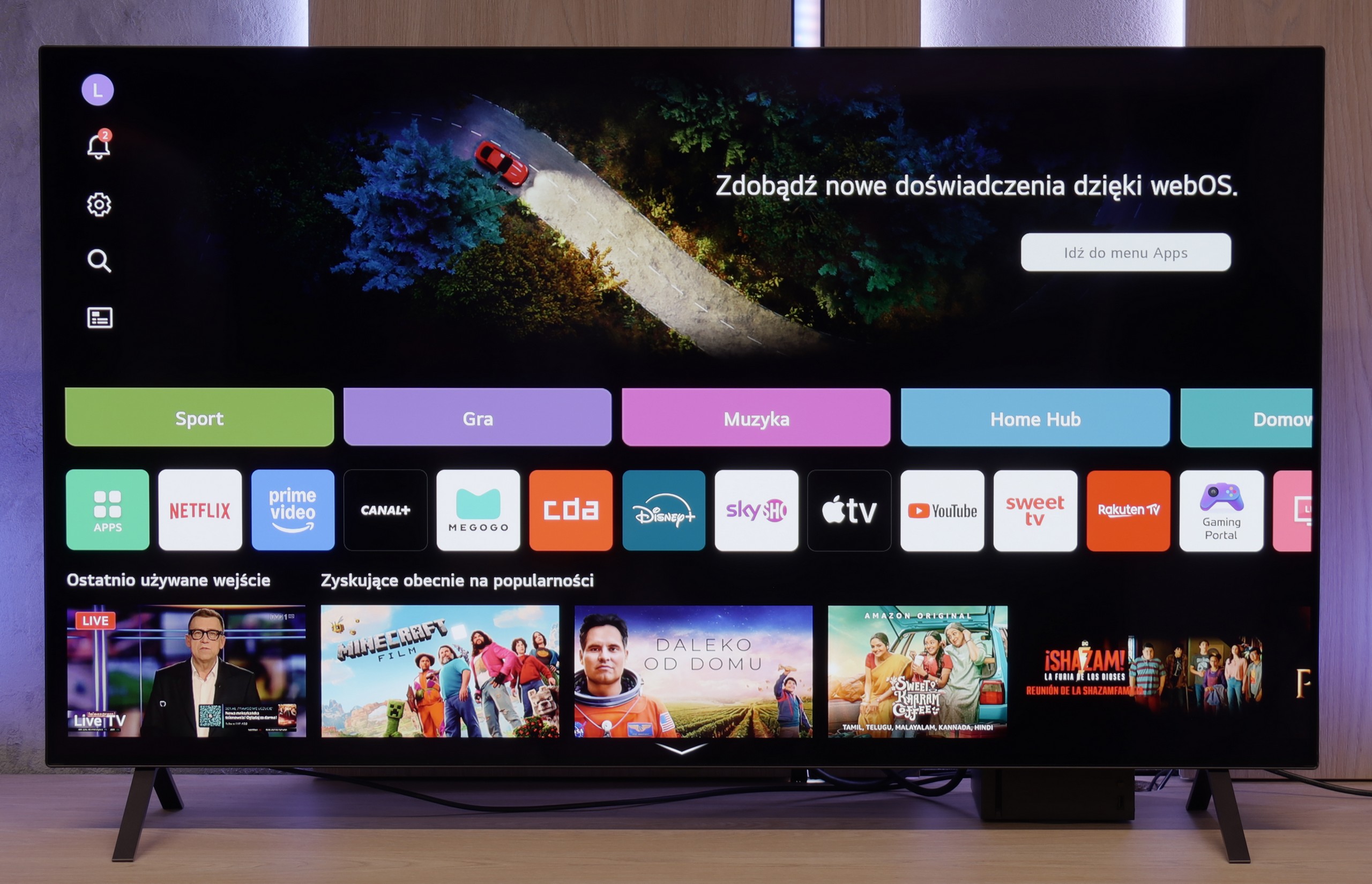
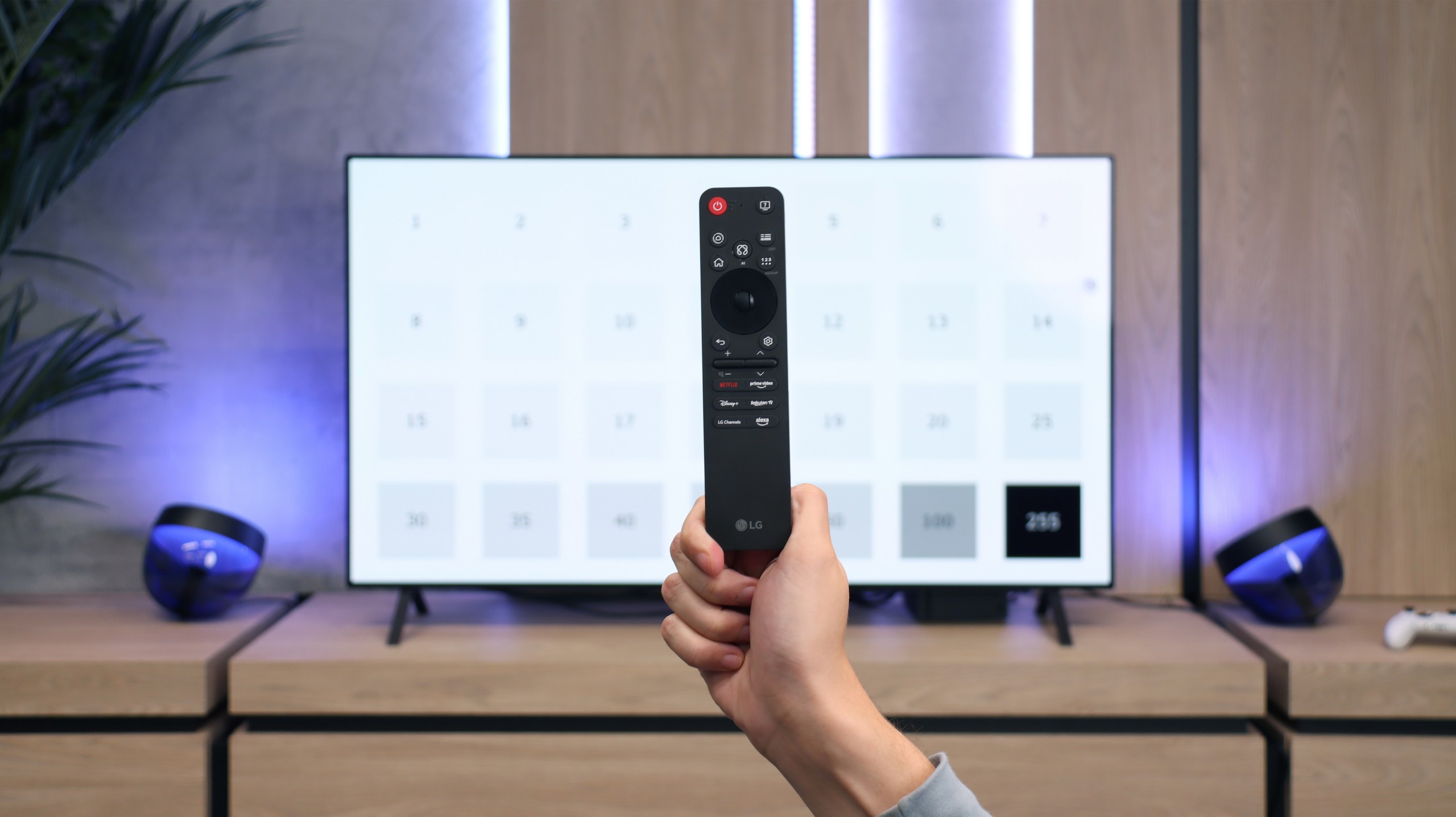
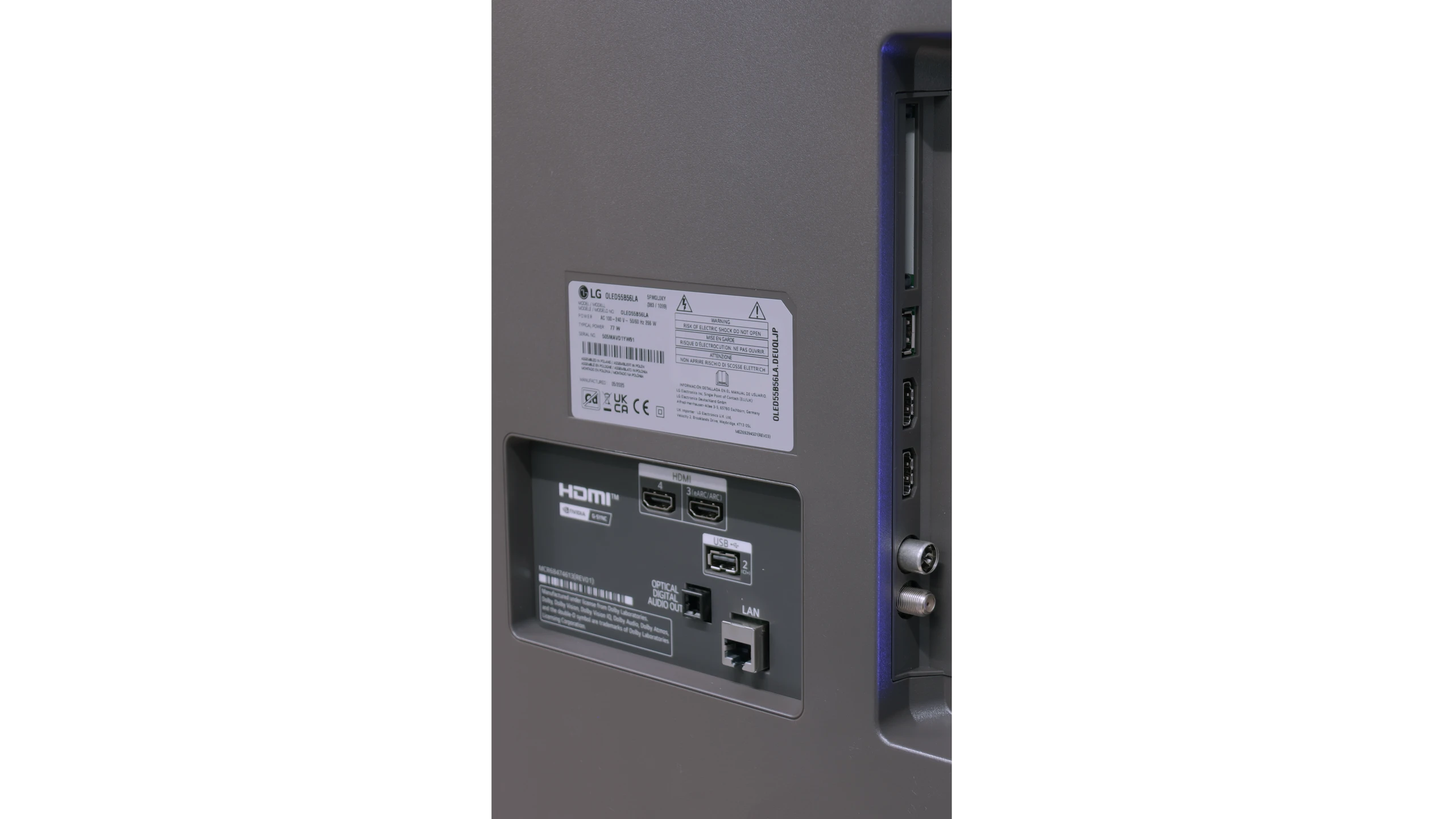
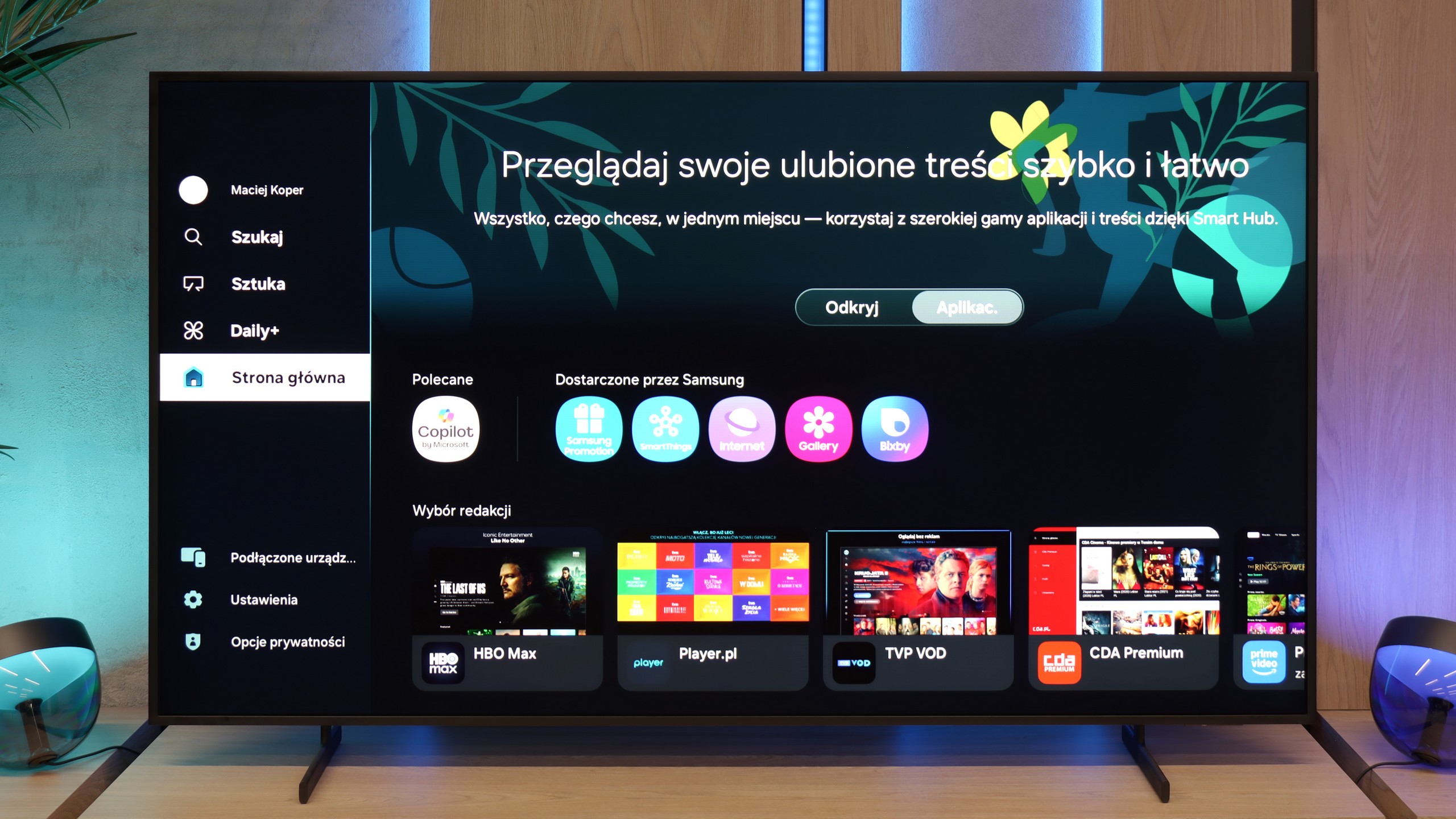
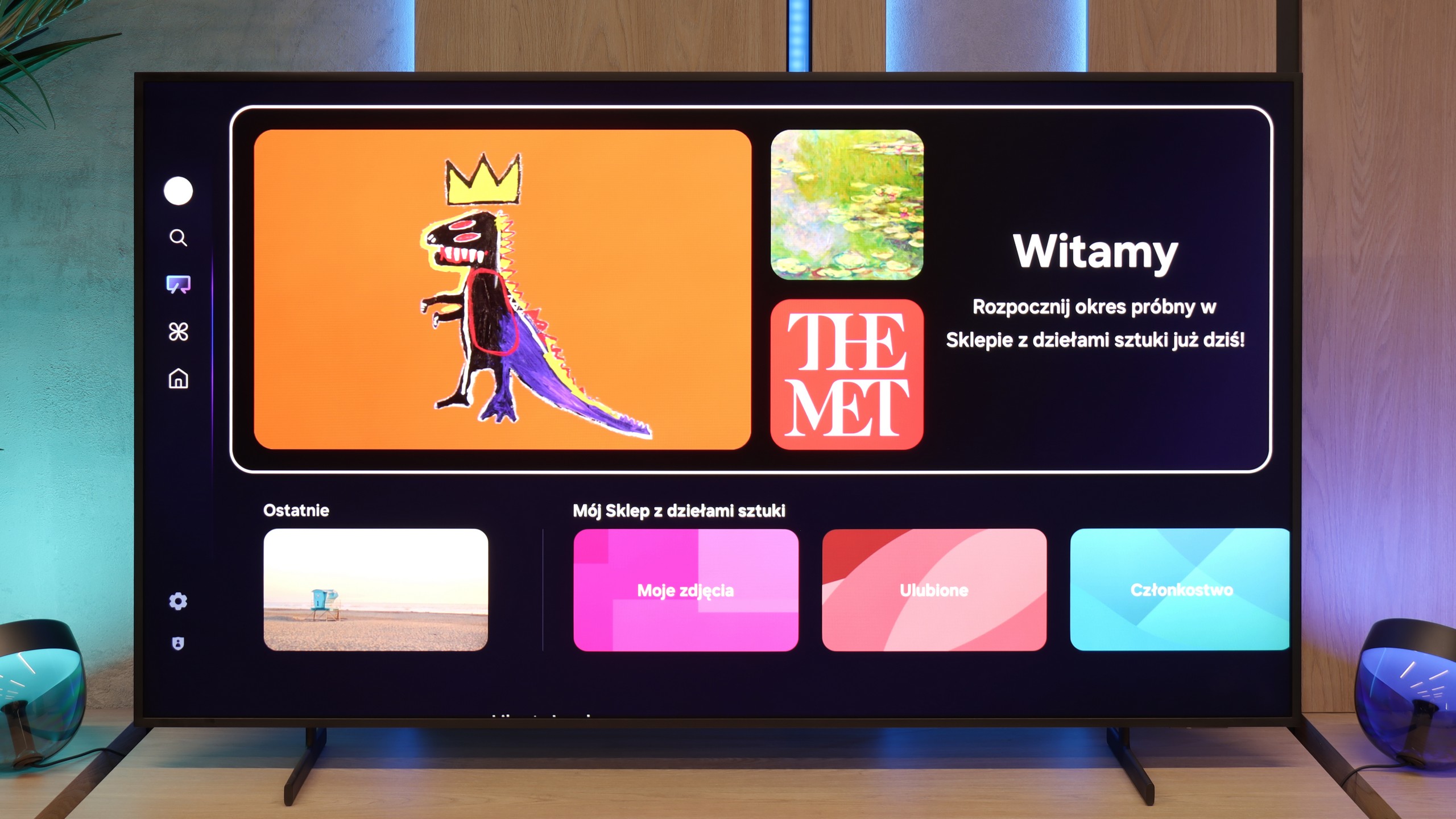
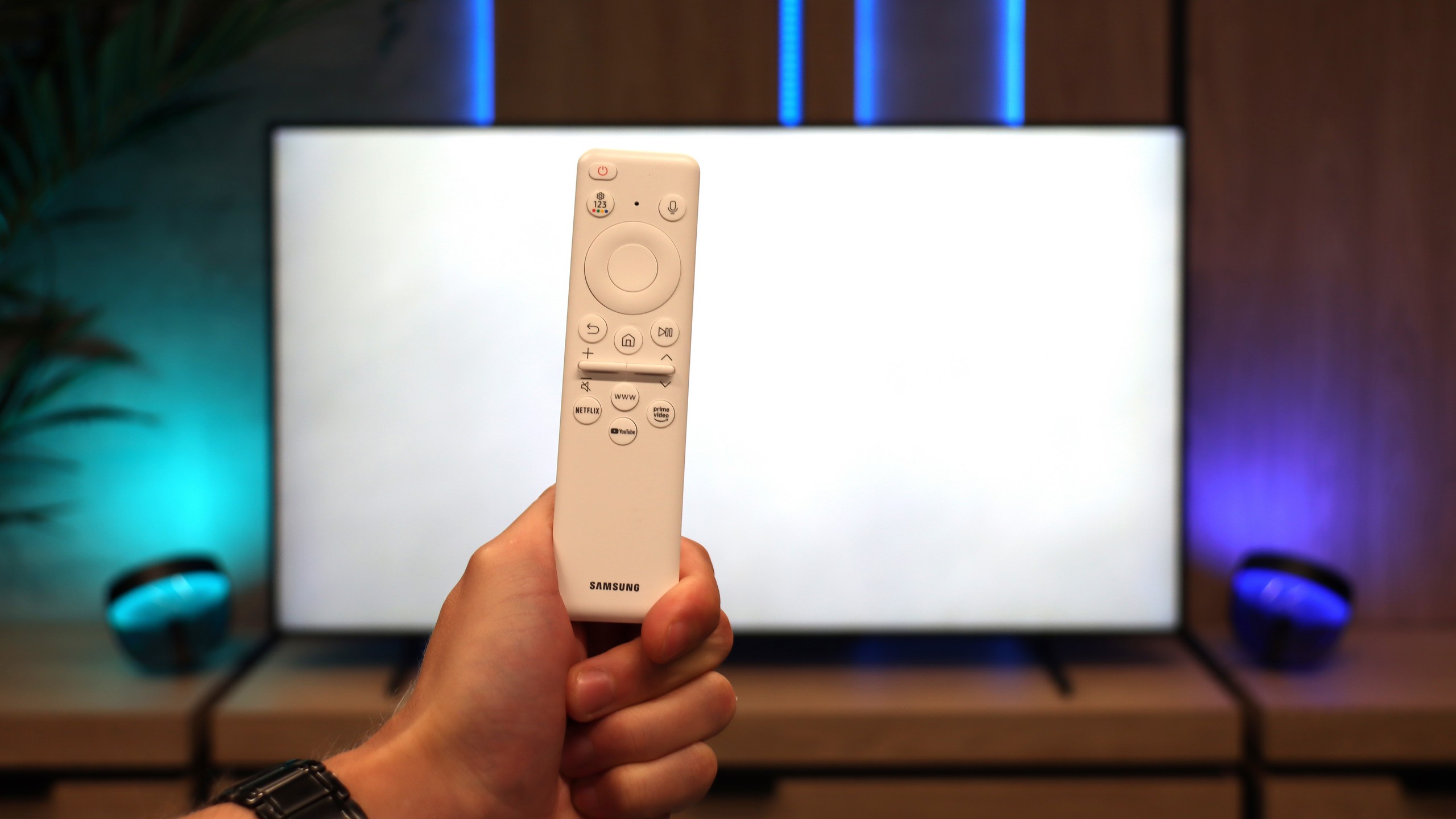
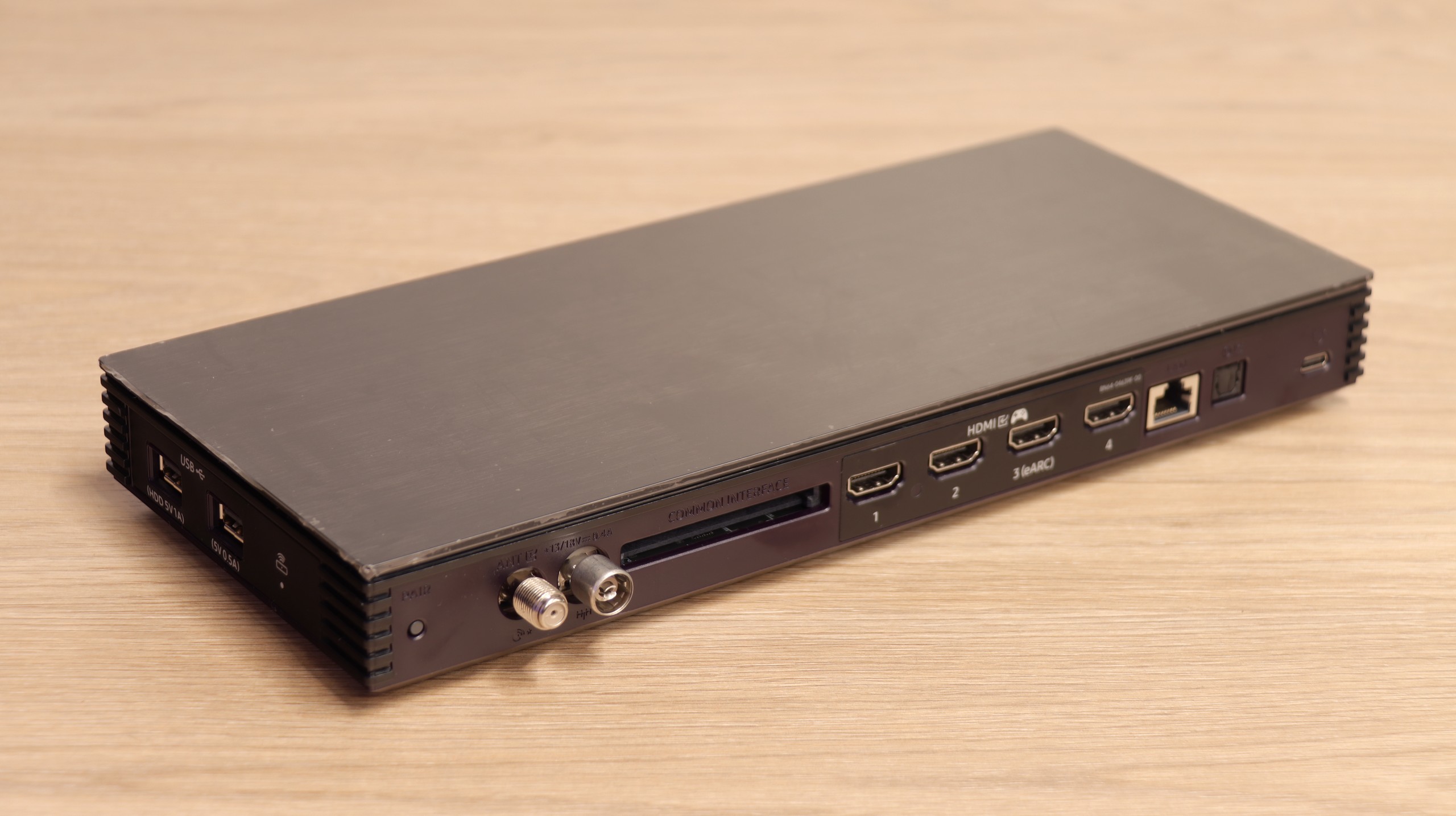
User Features
Although the LG B5 is modern equipment, they haven't forgotten about those who just want to… watch television sometimes. Without apps, without accounts, without logging in anywhere. We have built-in DVB-T2 tuners and the ability to record to USB, with a clear and fast EPG guide. Not enough? There’s even a functioning teletext – a relic for many, perhaps, but everyday life for others. We also appreciate the option to turn off the picture and leave just the sound, which works great for listening to music. And if you want to watch quietly – you can easily pair Bluetooth headphones, without struggling with settings and without delays. Everything works as it should.
SMART TV: webOS
The biggest distinguishing feature of the webOS system – still! – remains the way of control. The Magic remote that comes with the LG B5 (in our version B56 – the one without a numeric keypad) works like a magic wand. We point, click, select. And it just… works. Intuitively, quickly, and without unnecessary left-right arrow clicking. Additionally, there’s an AI voice assistant – quite capable. You can call it directly from the remote and use your voice to search content, change settings, or switch sources. While webOS itself may not be the most "modern" system on the market, and the built-in ads can be annoying, when it comes to user convenience – especially with the Magic remote – it still keeps a step ahead of the competition.
Smart Features
Samsung The Frame Pro runs on the Tizen system, which has been the hallmark of the Korean manufacturer for years. It is one of the most refined smart TV environments – fast, stable, and intuitive. It virtually includes all popular streaming applications, and the interface operates smoothly and without significant delays. Features such as AirPlay 2, screen mirroring, and voice control of the TV using Bixby, Alexa, or Google Assistant are also supported.
TV Functions
When it comes to classic TV functions – as in almost every Samsung – this is not the device's strongest aspect. We receive a clear EPG guide, teletext support, the ability to connect headphones via Bluetooth, and that's about it. We won't find more advanced tools known from TVs (e.g., USB recording or PiP). However, this is standard in Samsung's offering. The manufacturer has been setting trends for several years and focuses mainly on smart features, while traditional television is somewhat neglected.
Art Store and Interchangeable Frames – A Unique Element of the Series
What has distinguished the series The Frame since its inception is the Art Mode and the Art Store application. Thanks to it, we can display reproductions of artworks on the screen, ranging from classics to modern graphics. The service is indeed paid (in the form of a subscription or a one-time annual fee), but it ensures that the materials are prepared in the highest quality, making the displayed images look almost as if painted. This element, along with the option to change the TV's frames, makes The Frame Pro serve a dual purpose as a television and a stylish interior design element.
Wireless One Connect Module
The second unique element of The Frame PRO is the wireless One Connect module, which includes all HDMI ports and other connections. This allows the TV to hang on the wall almost like a real painting, while all the electronics and cables can be placed in a separate box positioned even a few meters away. The device is powered via USB-C and takes over all the "thinking" processes of the TV. While this solution has its limitations for gamers or those using PCs (latency, deterioration in font quality), it works great for connecting amplifiers, decoders, or individual multimedia devices. It's a very "gadgety" solution, but in everyday use, it proves to be simply convenient and allows for better arrangement of space in the living room.
Playing files from USB
8.6/10
9.1/10
Supported photo formats:
Maximum photo resolution:
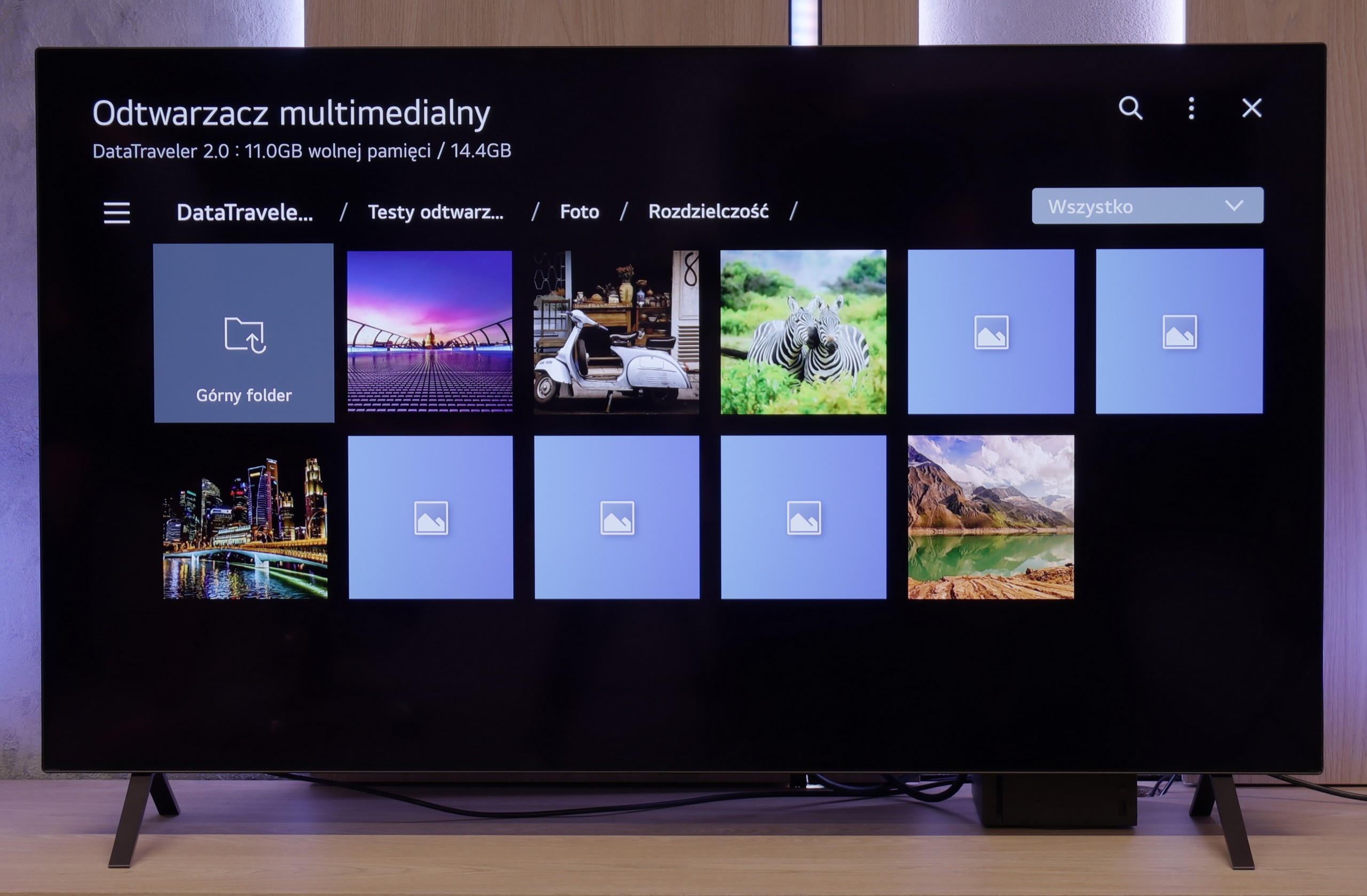
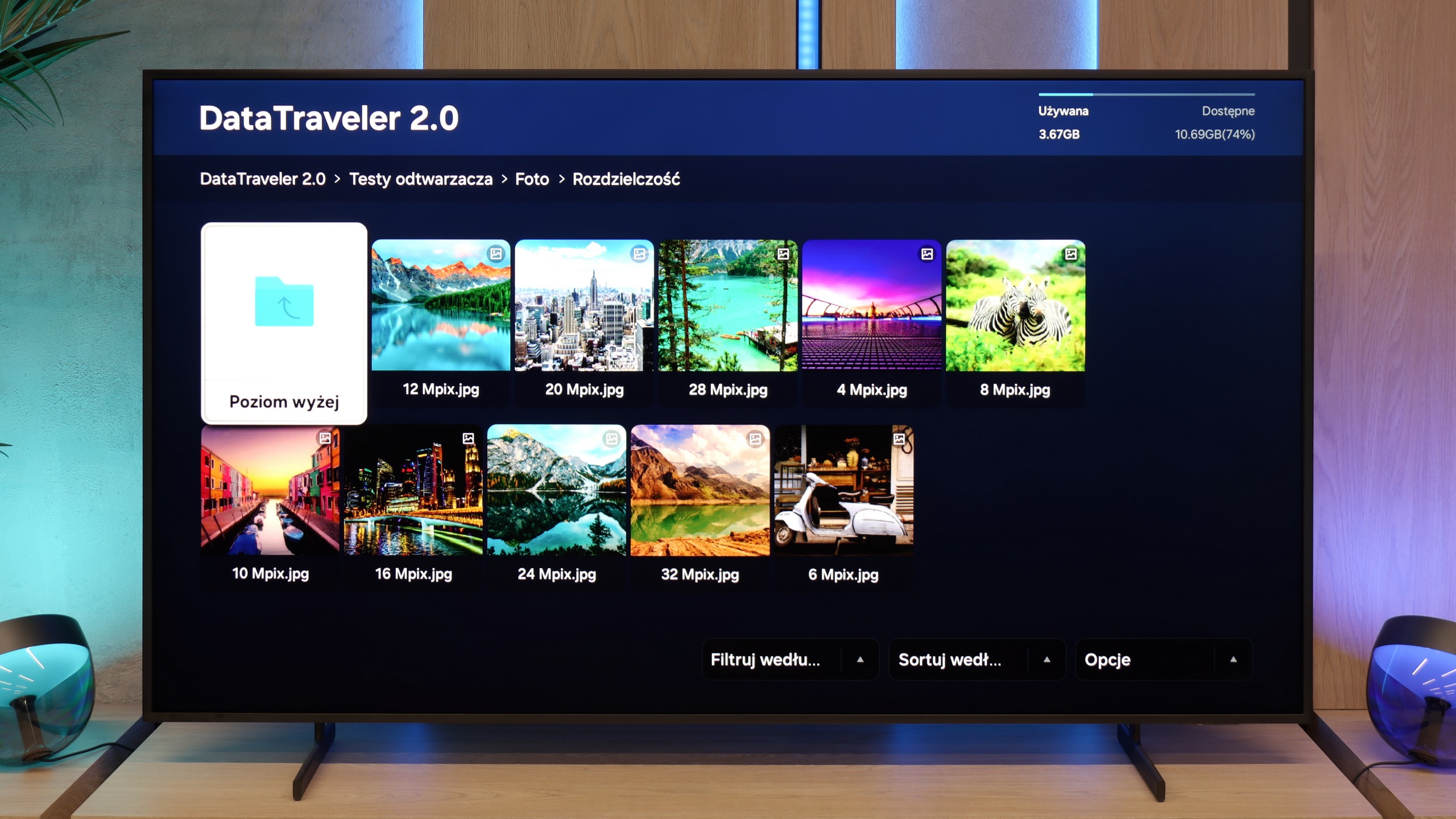
LG B5 handles files from USB as it should. Most popular formats work seamlessly, and subtitles – even with Polish characters – are displayed correctly. You can easily play a movie from a flash drive or do a weekend slideshow of your vacation photos without worrying that something will go wrong. However, there was a surprise with files in HEIC format – that is, photos saved by Apple devices. While LG C5 had no issues with them, the B5 stubbornly refused to cooperate and was unable to display them. A minor glitch that probably won’t affect everyone, but it's worth knowing about.
The Frame Pro handles multimedia playback from a USB drive correctly. Most popular movie, music, and photo formats work without major problems, and the TV manages them efficiently. During tests, we noticed only one inconvenience – files in HEIC format, which is a standard used by Apple, do not open even though the system sees them and displays them in the player. For those who often transfer photos from an iPhone, this may be a minor inconvenience, but apart from that, the player does its job well, and it's hard to have significant complaints about it.
Apps
9.1/10
8.7/10














































Sound
7/10
6.4/10
- Maximum volume85dB84dB
- Dolby Digital Plus 7.1
- Dolby True HD 7.1
- Dolby Atmos in Dolby Digital Plus (JOC)
- Dolby Atmos in Dolby True HD
- DTS:X in DTS-HD MA
- DTS-HD Master Audio
We didn't expect miracles – after all, the LG B5 doesn't have an advanced audio system, and its built-in speakers look... well, like those in most flat-screen TVs. And yet – it sounds quite pleasant. Dialogs are clear, the sound doesn't boom, and during a quieter viewing experience, we didn't immediately feel the need to connect a soundbar. It's just a pity that this year LG decided to cut something that worked in the previous generation. We're talking, of course, about support for DTS formats, which we won't find in the B5. If you have movies encoded in that standard – you'll need to rely on an external player.
The sound on The Frame Pro is not one of this TV's strongest features. Its slim design means there's virtually no bass, which makes the overall audio sound a bit flat and average. On the other hand, the TV plays loudly – it can easily fill a medium to larger room. Dialogues are clear, but when it comes to special effects or music, there’s a lack of depth. This is definitely a piece of equipment for which it's worth buying a soundbar, preferably from the designer Samsung S series. Thanks to decorative frames, it can be matched to the decor alongside ChooseTV.
Sound Quality Test
No sound test video
Acoustic Measurements
85dBC (Max)
75dBC
84dBC (Max)
75dBC
